Winter in South Carolina brings an array of beautiful and vibrant birds that grace the state with their presence during the colder months.
As the temperatures drop, many species of birds migrate from their breeding grounds in the north and seek refuge in the more temperate climate of South Carolina.
From the majestic Bald Eagle to the charming Eastern Bluebird, these winter birds bring a splash of color and a symphony of songs to the otherwise quiet landscape.
Whether you are an avid birder or find joy in observing nature’s wonders, the winter birds of South Carolina never fail to captivate and inspire.
1. Red-Bellied Woodpecker (Melanerpes carolinus)
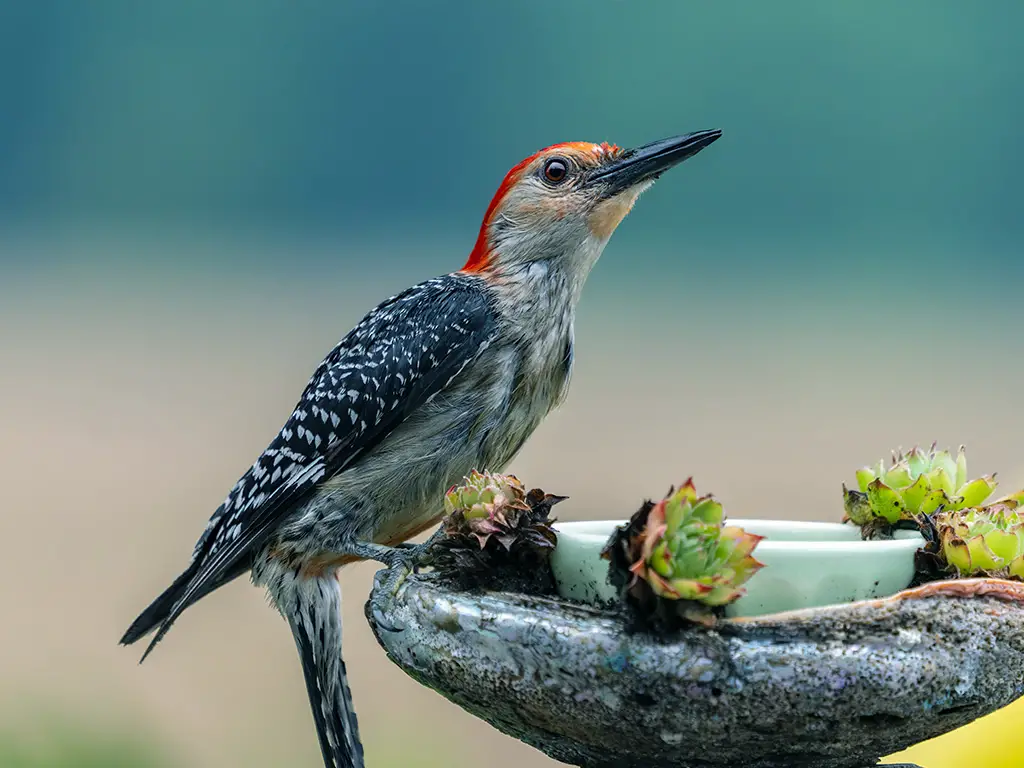
The Red-Bellied Woodpecker is a medium-sized woodpecker measuring 9-10 inches long. Despite its name, the red on its belly is often not visible. Instead, it has a red cap on its head, which is more prominent in males.
The rest of its plumage is black and white, with zebra-like stripes on its back. These woodpeckers are commonly found in woodlands, forests, and suburban areas across eastern North America.
They have a distinctive, rolling call that sounds like “churr-churr-churr.” Red-bellied woodpeckers feed on various food items, including insects, fruits, nuts, and seeds.
They are known for storing food in tree crevices for later consumption. These woodpeckers are skilled climbers and often forage on tree trunks and branches.
| Kingdom | Animalia |
| Phylum | Chordata |
| Clade | Dinosauria |
| Class | Aves |
| Order | Piciformes |
| Family | Picidae |
| Genus | Melanerpes |
| Species | M. carolinus |
2. House Finch (Haemorhous mexicanus)
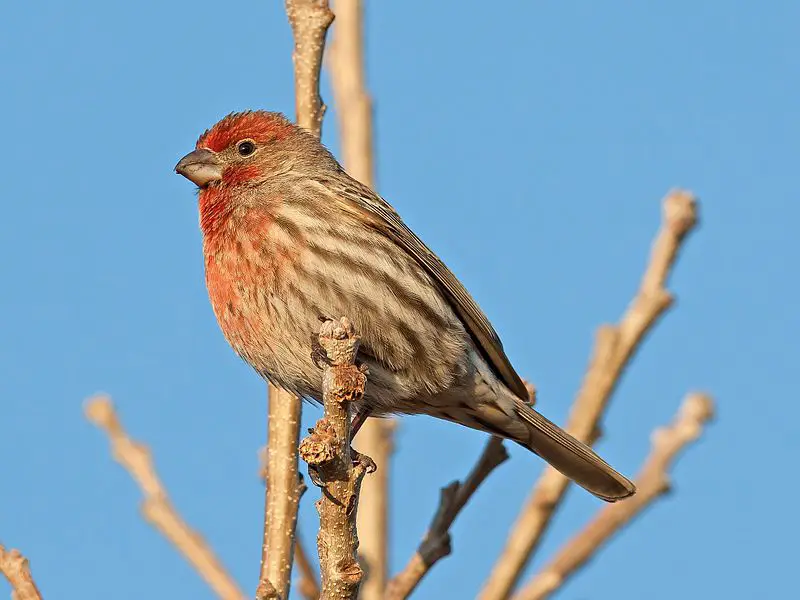
The House Finch is a small, colorful finch measuring 5-6 inches long. Males have vibrant red plumage on their heads, throats, and chests, while females have streaked brown and white plumage.
House Finches are highly adaptable birds in many habitats, including urban areas, gardens, and agricultural fields. They primarily feed on seeds, grains, and fruits, making them frequent visitors to bird feeders.
Their song is a cheerful, melodious warble, and they are known for their varied vocalizations. House Finches are year-round residents in many parts of North America and have successfully established populations in areas outside their native range.
They are social birds often seen in flocks, especially when foraging and roosting.
| Kingdom | Animalia |
| Phylum | Chordata |
| Clade | Dinosauria |
| Class | Aves |
| Order | Passeriformes |
| Family | Fringillidae |
| Genus | Haemorhous |
| Species | H. mexicanus |
3. Downy Woodpecker (Picoides pubescens)
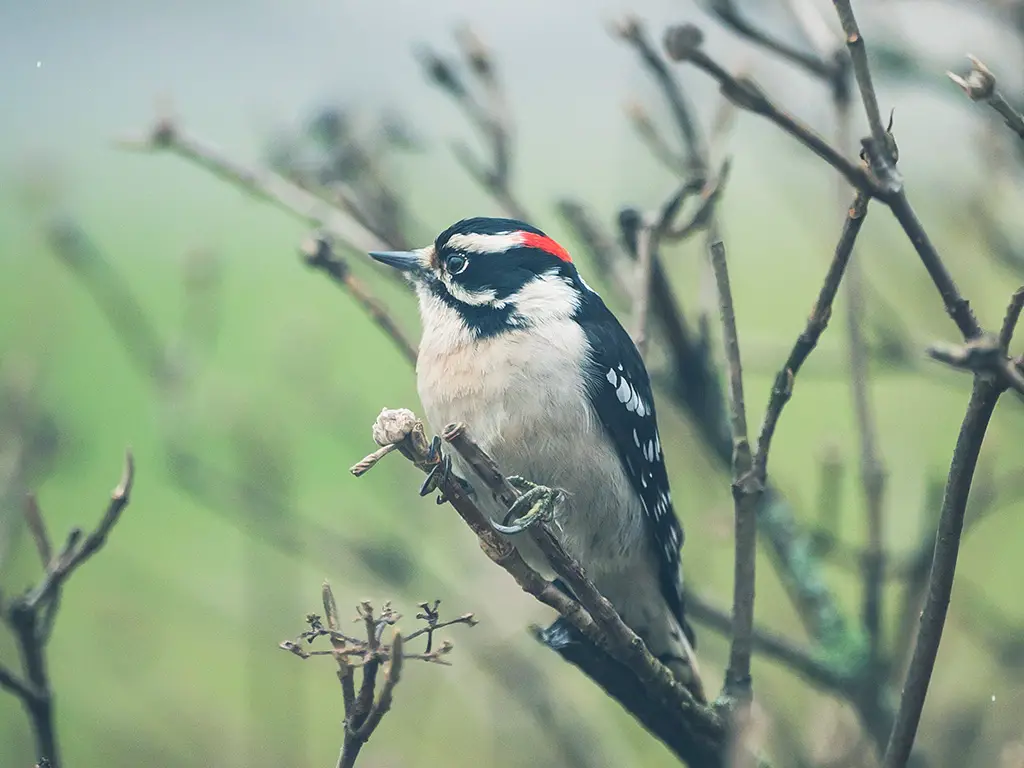
The Downy Woodpecker is a small woodpecker, measuring about 5.5-6.7 inches in length. It is similar in appearance to the larger Hairy Woodpecker but has a smaller bill and is more compact.
Downy Woodpeckers have striking black and white plumage, with a white belly and a distinct ladder-like pattern on their wings and back. Males have a small red patch on the back of their heads.
These woodpeckers are commonly found in a variety of habitats, including woodlands, parks, and suburban areas, and they often visit bird feeders.
They have a sharp, distinctive call that sounds like a high-pitched “pik.” Downy Woodpeckers feed primarily on insects, probing for them in tree bark and branches.
They are skilled climbers and are known for their drumming on dead tree limbs and other surfaces.
| Kingdom | Animalia |
| Phylum | Chordata |
| Clade | Dinosauria |
| Class | Aves |
| Order | Piciformes |
| Family | Picidae |
| Genus | Dryobates |
| Species | D. pubescens |
4. Northern Cardinal (Cardinalis cardinalis)
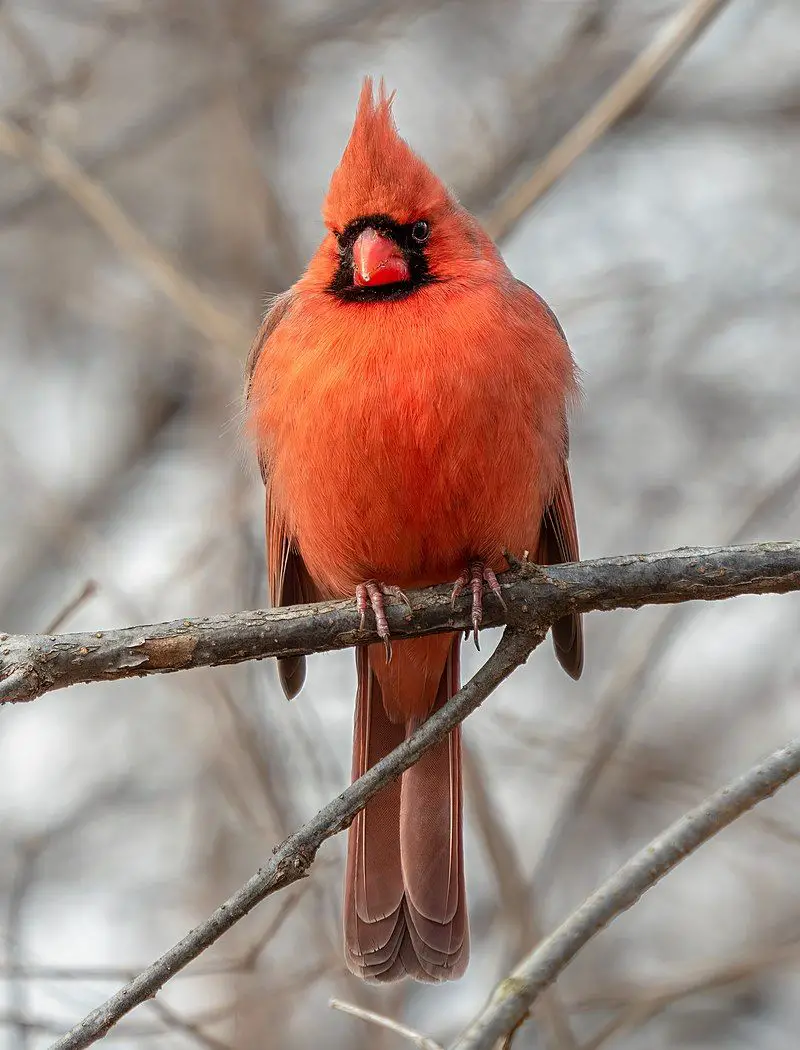
The Northern Cardinal is a medium-sized songbird, measuring about 8-9 inches in length. Males are known for their vibrant red plumage, crest on their heads, and black mask-like markings around their eyes.
Females have a more subdued brown plumage with red accents. Northern Cardinals are year-round residents in eastern North America, where they inhabit a variety of habitats, including woodlands, gardens, and suburban areas.
They are known for their clear, melodious songs and whistles. The male’s song is a loud string of clear down-slurred or two-parted whistles, often speeding up and ending in a slow trill. Females also sing, often while sitting on the nest.
These birds are primarily seed eaters but also consume fruits and insects. They do not migrate and are a familiar and beloved sight at bird feeders throughout the eastern and central United States.
Their presence is particularly striking in winter landscapes, making them a favorite among birdwatchers and nature enthusiasts. Northern Cardinals often mate for life, and pairs are known to stay together year-round.
Their vivid appearance and endearing behaviors have made them a symbol of beauty and love in many cultures.
| Kingdom | Animalia |
| Phylum | Chordata |
| Clade | Dinosauria |
| Class | Aves |
| Order | Passeriformes |
| Family | Cardinalidae |
| Genus | Cardinalis |
| Species | C. cardinalis |
5. Blue Jay (Cyanocitta cristata)
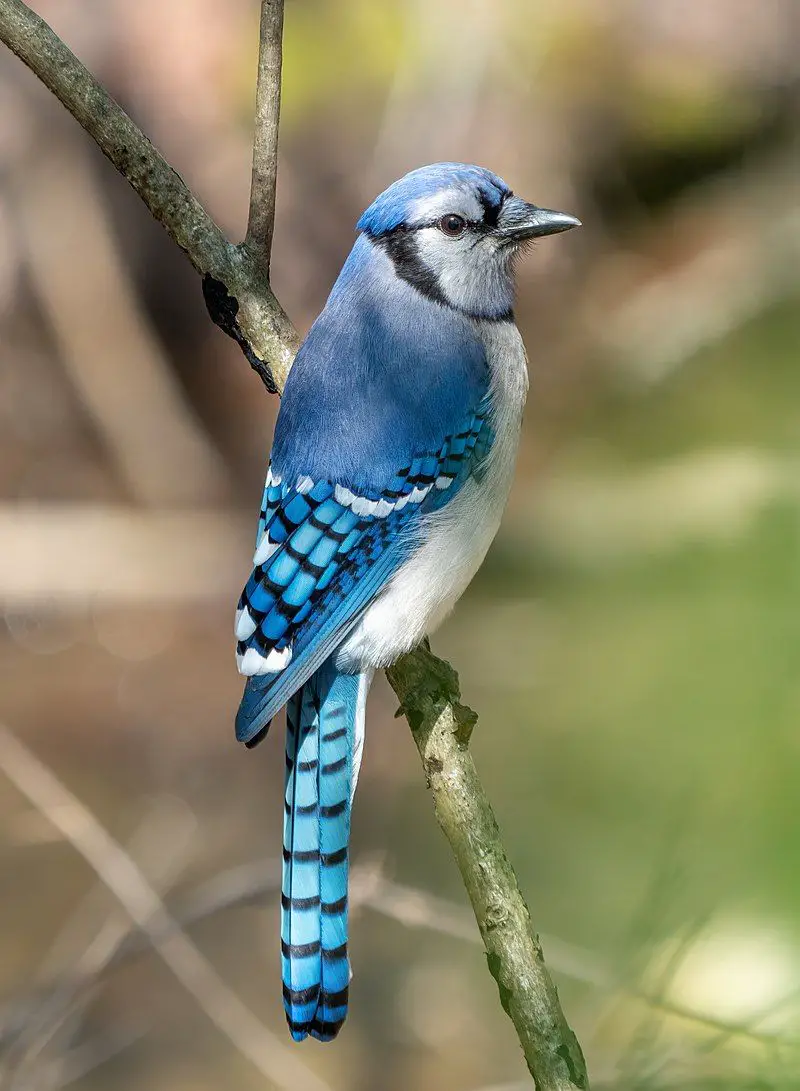
The Blue Jay is a striking and noisy bird, measuring about 9-12 inches in length. It has bright blue plumage on its upperparts, a white face, and a black collar that extends down to its chest. Blue Jays are known for their distinctive crest on their heads.
These birds are highly adaptable and are commonly found in a range of habitats, including woodlands, parks, and urban areas. They are known for their loud, raucous calls and mimicry of other bird species.
Blue Jays are omnivorous and have a varied diet that includes seeds, nuts, insects, fruits, and even small vertebrates. They are skilled at caching food, hiding it in various locations for later consumption.
Blue Jays are also known for their social behavior, often traveling and foraging in noisy groups. Despite their bold and sometimes aggressive nature, their beauty and intelligence make them a favorite among birdwatchers.
| Kingdom | Animalia |
| Phylum | Chordata |
| Clade | Dinosauria |
| Class | Aves |
| Order | Passeriformes |
| Family | Corvidae |
| Genus | Cyanocitta |
| Species | C. cristata |
6. Carolina Chickadee (Poecile carolinensis)
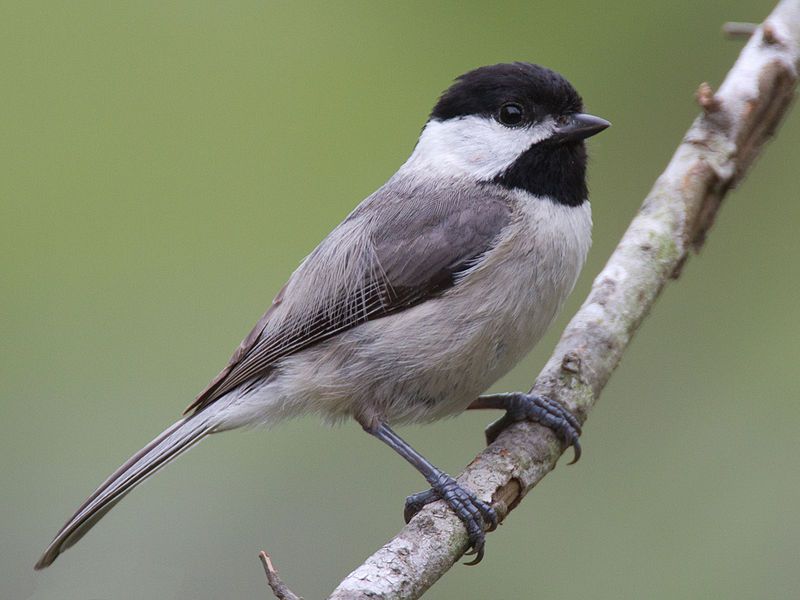
The Carolina Chickadee is a small, lively bird, measuring about 4.5-5.5 inches in length. It has a distinctive black cap and throat, white cheeks, and a grayish body.
These chickadees are often found in woodlands, parks, and gardens across the southeastern United States. They are known for their cheerful “chick-a-dee-dee-dee” call and their signature song, a clear “fee-bee” or “fee-bee-fee.”
Carolina Chickadees primarily feed on insects, seeds, and berries. They are agile foragers, often hanging upside down to glean insects from leaves and bark.
These birds are cavity nesters, using natural tree cavities or nest boxes. They are social birds and are often seen in mixed-species flocks during winter foraging.
| Kingdom | Animalia |
| Phylum | Chordata |
| Clade | Dinosauria |
| Class | Aves |
| Order | Passeriformes |
| Family | Paridae |
| Genus | Poecile |
| Species | P. carolinensis |
7. American Goldfinch (Spinus tristis)
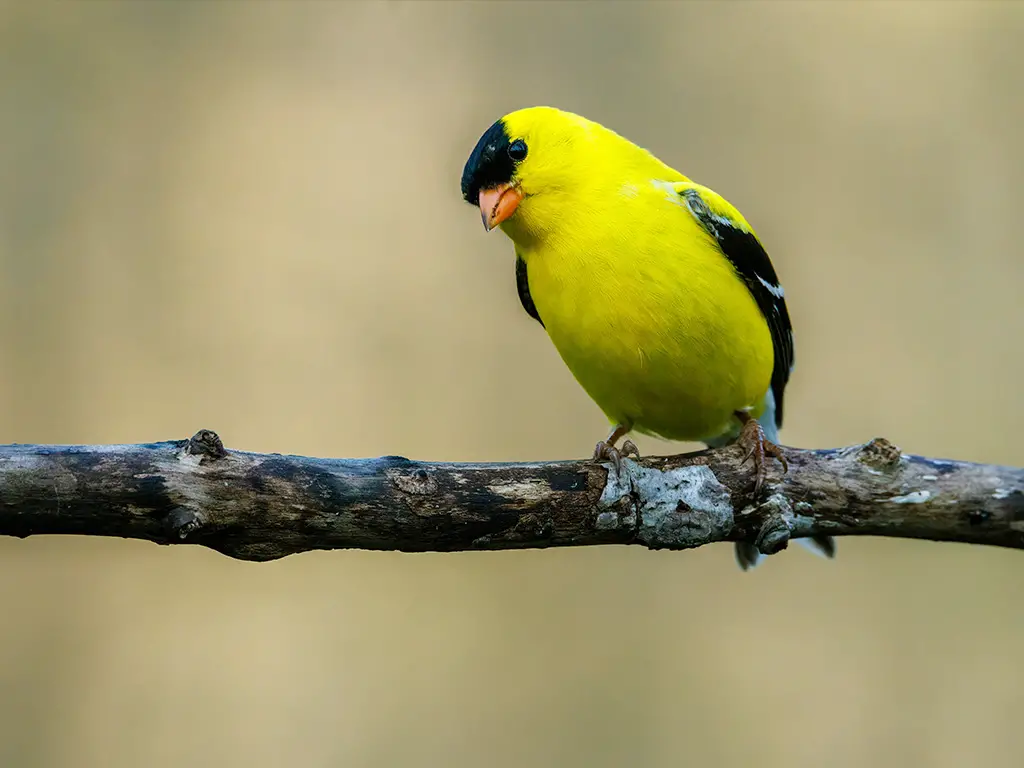
The American Goldfinch, also known as the Eastern Goldfinch or Wild Canary, is a small songbird, measuring about 4.3-5.1 inches in length. During the breeding season, males have vibrant yellow plumage with black wings and tails.
In winter, both males and females adopt a more subdued olive-brown plumage. These finches are commonly found in fields, gardens, and meadows across North America.
They are known for their distinctive flight call, often described as “potato-chip.” American Goldfinches are primarily seed-eaters, with a preference for thistle seeds.
They are often seen perched on seed heads, extracting seeds with their specialized bills. These birds are also known for their late breeding season, which coincides with the availability of seeds. They build nests in shrubs and trees, using plant fibers and down to create a cozy lining.
| Kingdom | Animalia |
| Phylum | Chordata |
| Clade | Dinosauria |
| Class | Aves |
| Order | Passeriformes |
| Family | Fringillidae |
| Genus | Spinus |
| Species | S. tristis |
8. Carolina Wren (Thryothorus ludovicianus)
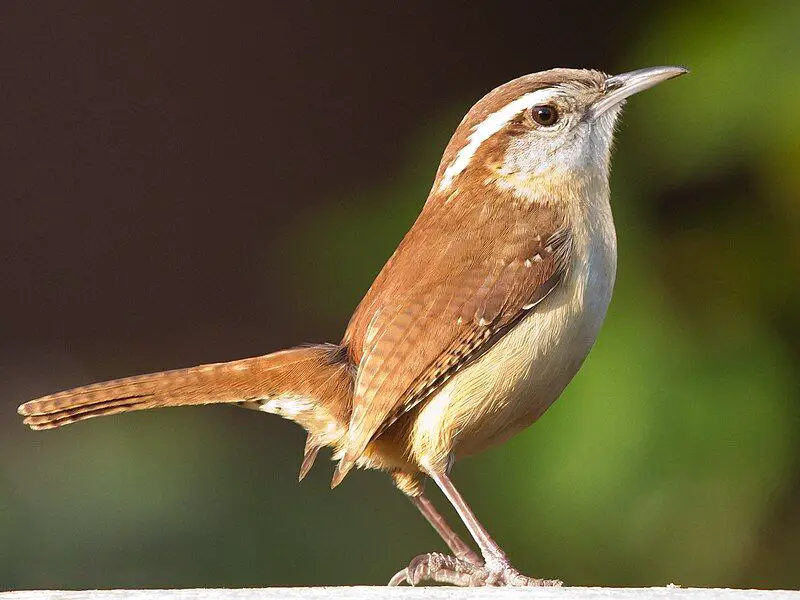
The Carolina Wren is a small, charismatic bird, measuring about 4.7-5.9 inches in length. It has rich reddish-brown plumage, a distinctive white eyebrow stripe, and a slightly curved bill.
These wrens are commonly found in woodlands, shrubby areas, and urban gardens throughout the eastern United States. They are known for their loud and melodious song, which is often described as “teakettle, teakettle, teakettle” or “cheerily, cheerily, cheerily.”
Carolina Wrens are highly vocal year-round and are often heard before they are seen. They feed primarily on insects, spiders, and small invertebrates, using their long bills to probe in crevices and leaf litter.
These wrens build dome-shaped nests in various sheltered locations, including tree cavities, planters, and even mailboxes. They are known for their bold and inquisitive nature, often approaching human observers with curiosity.
| Kingdom | Animalia |
| Phylum | Chordata |
| Clade | Dinosauria |
| Class | Aves |
| Order | Passeriformes |
| Family | Troglodytidae |
| Genus | Thryothorus |
| Species | T. ludovicianus |
9. Mourning Dove (Zenaida macroura)
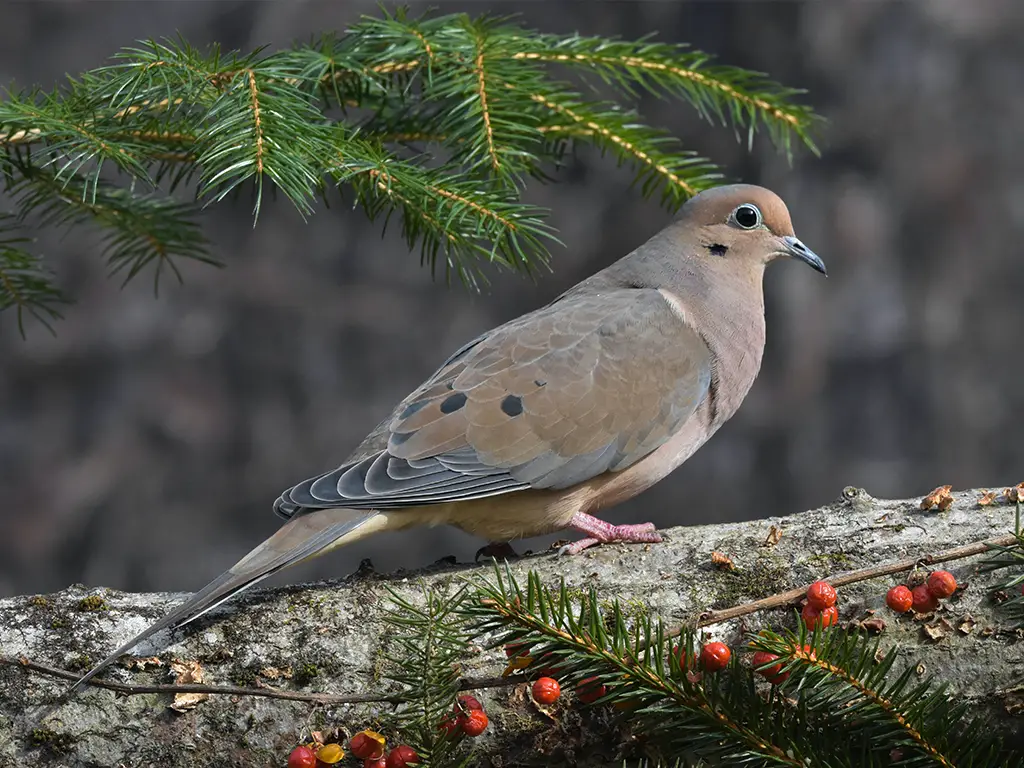
The Mourning Dove is a medium-sized bird, measuring about 9-13 inches in length with a wingspan of 17-18 inches. It has a subdued grayish-brown plumage with a light pinkish hue on the chest.
Mourning Doves are known for their soft, mournful cooing calls, which have earned them their name. These doves are widespread throughout North America, often found in a variety of habitats, including open fields, woodlands, and urban areas.
They primarily feed on seeds, including those of grasses and weeds. Their gentle cooing calls are a common sound in suburban neighborhoods.
Mourning Doves are monogamous and often seen in pairs. They build flimsy nests in trees and shrubs and are known for their rapid and agile flight, with wingbeats producing a distinctive whistling sound.
| Kingdom | Animalia |
| Phylum | Chordata |
| Clade | Dinosauria |
| Class | Aves |
| Order | Columbiformes |
| Family | Columbidae |
| Genus | Zenaida |
| Species | Z. macroura |
10. Tufted Titmouse (Baeolophus bicolor)
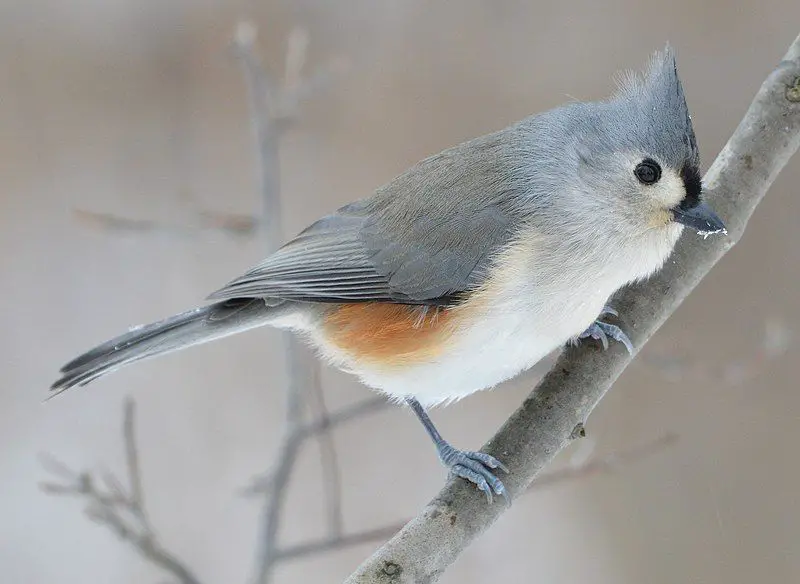
The Tufted Titmouse is a small, active bird, measuring about 5.5-6.3 inches in length. It has a gray upper body, white underparts, and a distinctive black forehead patch and crown.
These titmice are commonly found in deciduous woodlands, parks, and suburban areas across eastern North America. They are known for their clear, whistled “peter-peter-peter” song and various vocalizations.
Tufted Titmice primarily feeds on insects, seeds, and berries. They are skilled foragers, often storing food in crevices for later use. These birds are cavity nesters, using natural tree cavities or nest boxes.
They are social and often seen in mixed-species flocks with other small birds during foraging. Tufted Titmice are known for their agility in navigating tree branches and their boldness at bird feeders.
| Kingdom | Animalia |
| Phylum | Chordata |
| Clade | Dinosauria |
| Class | Aves |
| Order | Passeriformes |
| Family | Paridae |
| Genus | Baeolophus |
| Species | B. bicolor |
11. Eastern Bluebird (Sialia sialis)
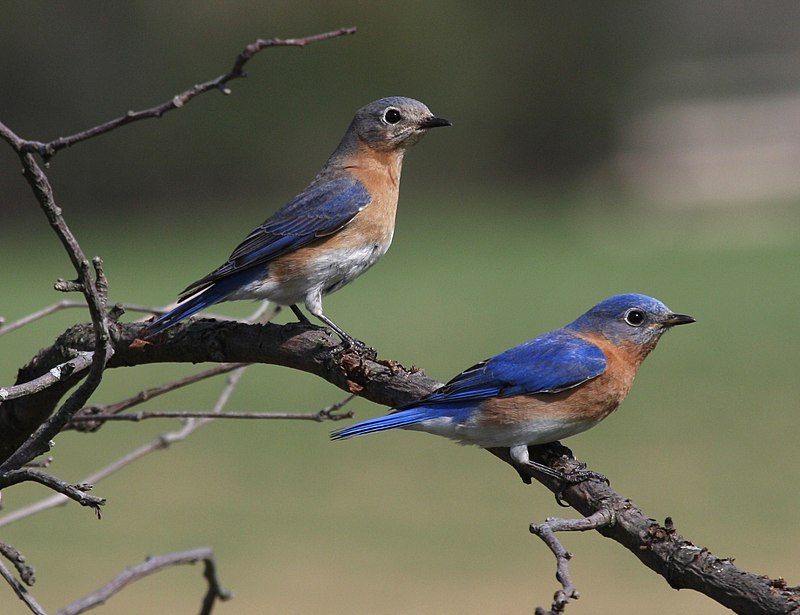
The Eastern Bluebird is a small and vibrant songbird, measuring about 6.3-8 inches in length. Males have striking blue plumage on their heads, backs, wings, and tails, while females are slightly duller in color.
These bluebirds are often found in open woodlands, meadows, and suburban areas across eastern North America. They are known for their melodious, warbling songs and calls. Eastern Bluebirds primarily feed on insects, berries, and small fruits.
They are skilled hunters, often seen perched on wires or branches, scanning for insects on the ground. These birds are cavity nesters and readily accept nest boxes provided by humans.
They are known for their resilience, as their populations declined in the past but have rebounded thanks to conservation efforts and the provision of nest boxes. Eastern Bluebirds are a symbol of hope and happiness for many birdwatchers.
| Kingdom | Animalia |
| Phylum | Chordata |
| Clade | Dinosauria |
| Class | Aves |
| Order | Passeriformes |
| Family | Turdidae |
| Genus | Sialia |
| Species | S. sialis |
12. White-Throated Sparrow (Zonotrichia albicollis)
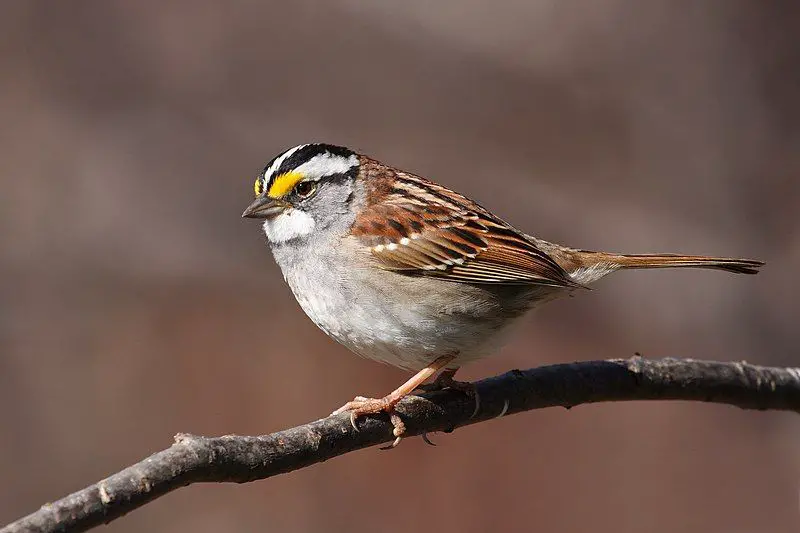
The White-Throated Sparrow is a medium-sized sparrow, measuring about 6.3-7.9 inches in length. It has a distinct white throat and belly, a gray face with yellow lores, and distinctive black and white stripes on its head.
These sparrows are often found in woodlands, shrubby areas, and gardens across eastern North America. They are known for their clear, whistled song that can be described as “Oh-sweet-canada-canada” or “Old-Sam-Peabody-Peabody.”
White-Throated Sparrows primarily feed on seeds, fruits, and insects, often foraging on the ground or in low vegetation. They are migratory birds, with distinct populations in the eastern and western parts of North America.
These sparrows are known for their bold and curious nature, often approaching human observers closely. They are social birds, often seen in flocks during the non-breeding season.
| Kingdom | Animalia |
| Phylum | Chordata |
| Clade | Dinosauria |
| Class | Aves |
| Order | Passeriformes |
| Family | Passerellidae |
| Genus | Zonotrichia |
| Species | Z. albicollis |
13. Yellow-Rumped Warbler (Setophaga coronata)
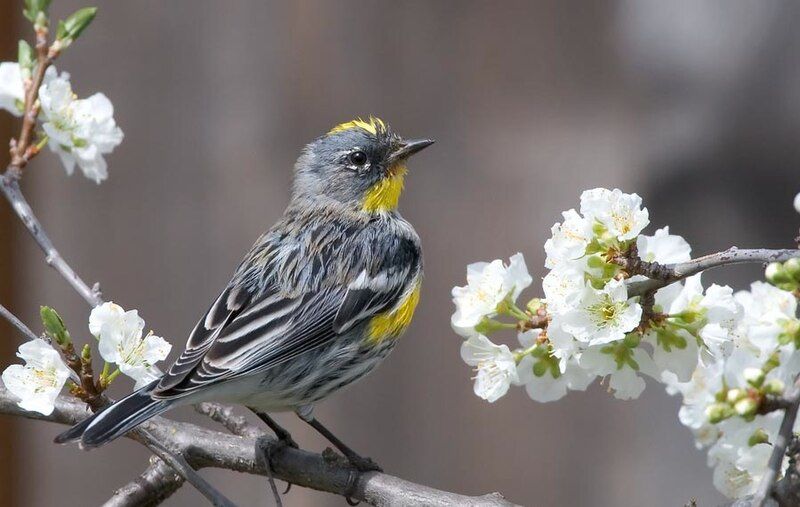
he Yellow-Rumped Warbler, often called the “butter-butt” due to its yellow rump, is a small songbird measuring about 5-6 inches in length.
It’s known for its striking plumage, featuring a yellow throat, yellow patches on the sides, and a yellow rump (in some subspecies), combined with a grayish-blue back.
These warblers are widespread across North America, and found in various habitats, including forests, woodlands, and even urban gardens.
They have a soft, musical song and are skilled insect hunters, but they can also switch to eating berries in the winter when insects are scarce.
| Kingdom | Animalia |
| Phylum | Chordata |
| Clade | Dinosauria |
| Class | Aves |
| Order | Passeriformes |
| Family | Parulidae |
| Genus | Setophaga |
| Species | S. coronata |
14. Pileated Woodpecker (Dryocopus pileatus)
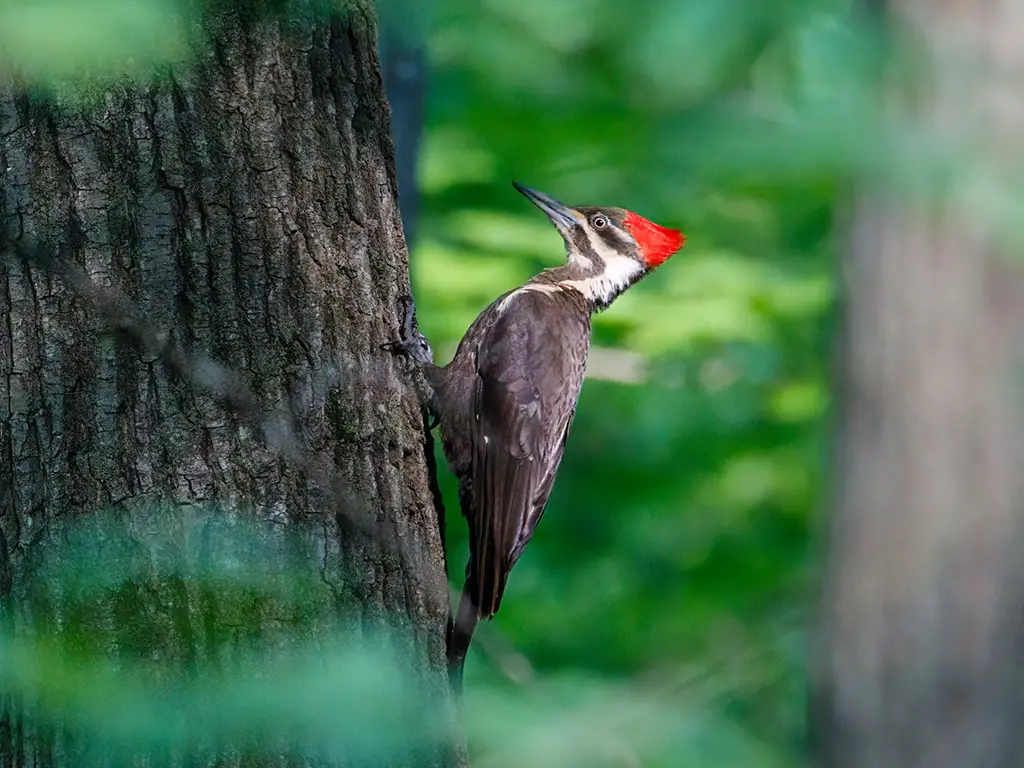
The Pileated Woodpecker is one of the largest woodpecker species in North America, measuring around 16-19 inches in length. It boasts striking black plumage with a prominent red crest on its head.
These woodpeckers are often associated with mature forests and are known for their loud, resonant drumming and calls. Pileated Woodpeckers are skilled foragers, using their powerful bills to excavate tree trunks in search of insects and larvae.
They also feed on fruits and nuts. These woodpeckers play a crucial role in forest ecosystems by creating cavities that provide nesting sites for various bird species.
| Kingdom | Animalia |
| Phylum | Chordata |
| Clade | Dinosauria |
| Class | Aves |
| Order | Piciformes |
| Family | Picidae |
| Genus | Dryocopus |
| Species | D. pileatus |
15. American Robin (Turdus migratorius)
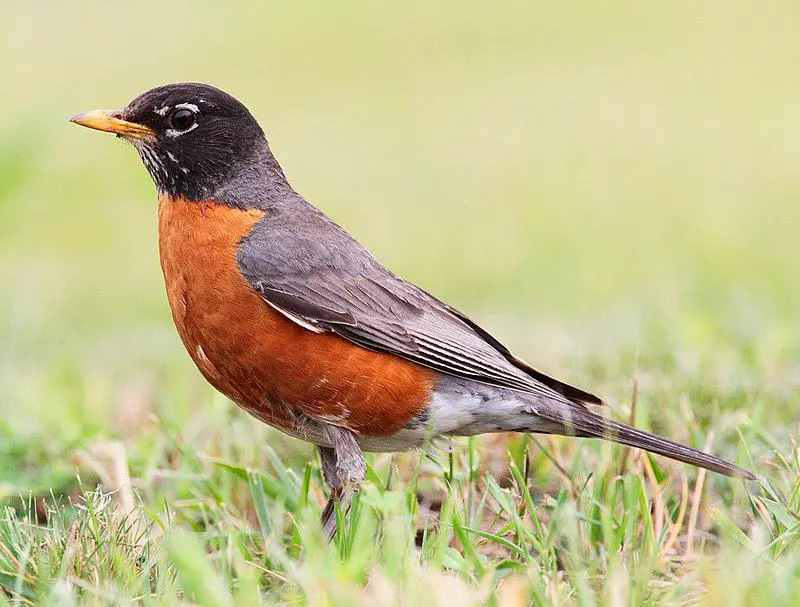
The American Robin is a familiar and widely recognized bird, measuring about 8-11 inches in length. It has a distinctive orange-red breast, a grayish-black back, and a white eye ring.
These robins are known for their cheerful, melodious song, often heard during the early morning hours. American Robins are commonly found in a range of habitats, including woodlands, gardens, and urban areas, and are known for their adaptability.
They primarily feed on earthworms, insects, and fruits. While they are known for their presence in North America during the spring and summer, some populations also overwinter in milder regions, making them a year-round sight for many.
| Kingdom | Animalia |
| Phylum | Chordata |
| Clade | Dinosauria |
| Class | Aves |
| Order | Passeriformes |
| Family | Turdidae |
| Genus | Turdus |
| Species | T. migratorius |
16. Northern Mockingbird (Mimus polyglottos)
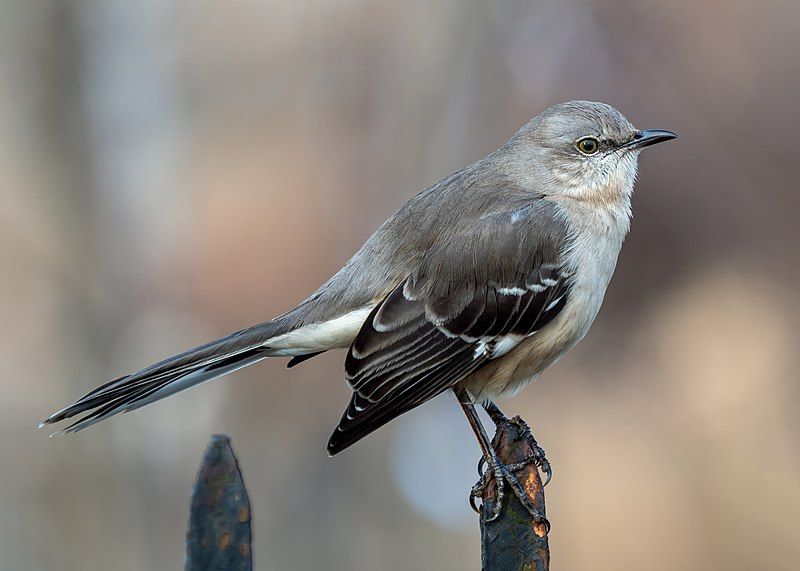
The Northern Mockingbird is a medium-sized songbird, measuring about 8.5-10 inches in length. It has gray plumage with white wing patches and a long, slender tail.
These mockingbirds are known for their remarkable ability to mimic the songs and calls of other birds, hence their name. They have a diverse repertoire of songs and can imitate other bird species, insects, and even mechanical sounds.
Northern Mockingbirds are commonly found in open habitats, including suburban areas, where they perch prominently to sing. They feed on a variety of insects, berries, and fruits.
These birds are territorial and are known for their assertive behavior when defending their nesting areas.
| Kingdom | Animalia |
| Phylum | Chordata |
| Clade | Dinosauria |
| Class | Aves |
| Order | Passeriformes |
| Family | Mimidae |
| Genus | Mimus |
| Species | M. polyglottos |
17. Wrens (Troglodytidae Family)
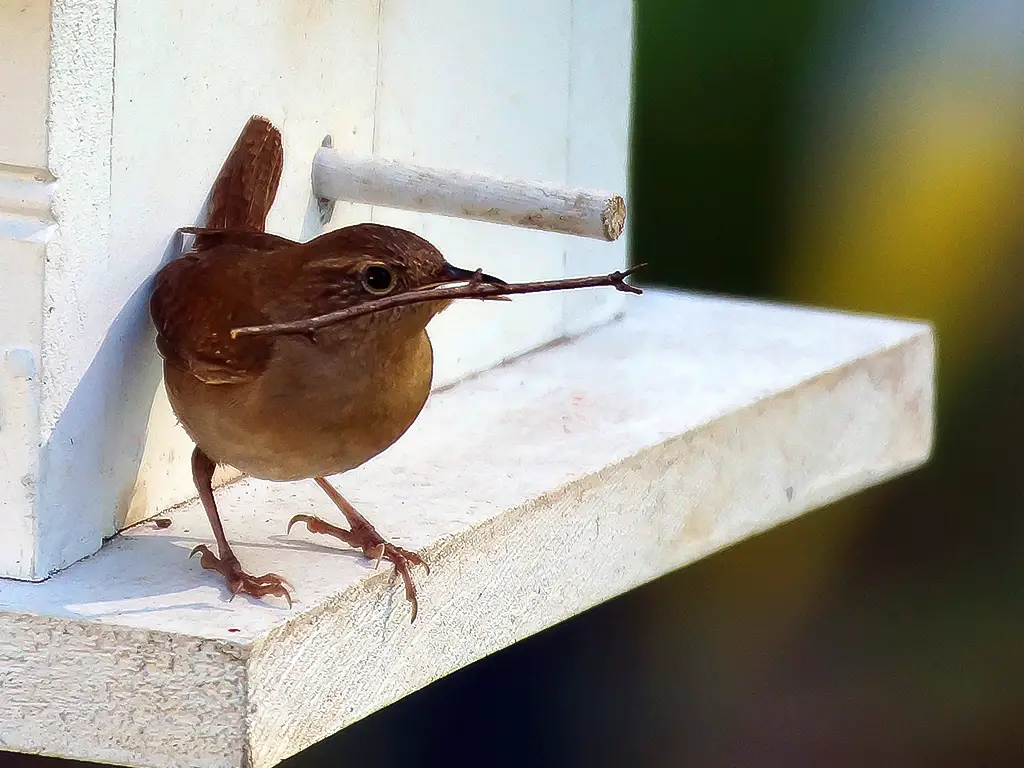
Wrens are a diverse family of small songbirds known for their energetic and melodious songs. Species in this family include the Carolina Wren, House Wren, and Bewick’s Wren, among others.
These birds are characterized by their compact size, often measuring around 4-6 inches in length, and their upright tail posture.
Wrens are highly adaptable and can be found in a variety of habitats, from woodlands and forests to gardens and urban areas.
They primarily feed on insects, spiders, and small invertebrates, foraging actively in search of prey. Wrens are known for their vibrant songs, which vary among species but are generally loud and complex.
| Kingdom | Animalia |
| Phylum | Chordata |
| Clade | Dinosauria |
| Class | Aves |
| Order | Passeriformes |
| Family | Troglodytidae |
18. Pine Warbler (Setophaga pinus)
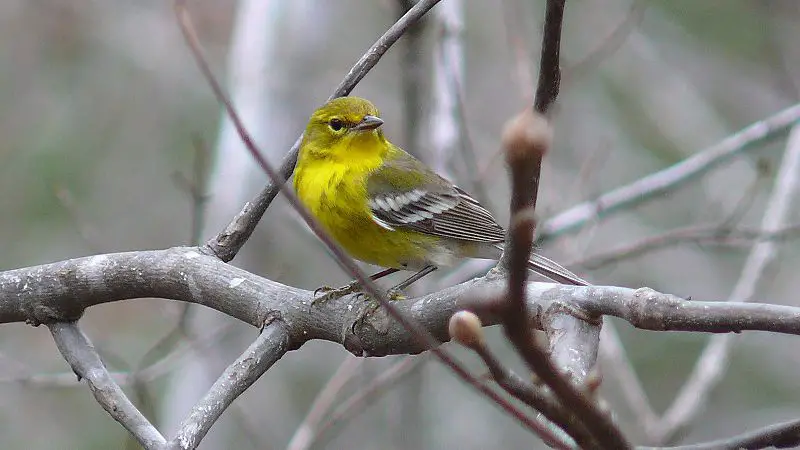
The Pine Warbler is a small songbird measuring about 4.7-5.5 inches in length. It has a greenish-yellow plumage with a distinctive white belly and dark streaks on its sides. These warblers are primarily found in pine forests across eastern North America.
They are known for their high-pitched, musical trill, often heard in the treetops. Pine Warblers primarily feed on insects, spiders, and pine seeds.
They are skilled at foraging on pine branches and needles, where they find insects and extract seeds from pine cones. These warblers are typically non-migratory and can be seen year-round in their preferred pine habitats.
| Kingdom | Animalia |
| Phylum | Chordata |
| Clade | Dinosauria |
| Class | Aves |
| Order | Passeriformes |
| Family | Parulidae |
| Genus | Setophaga |
| Species | S. pinus |
19. American Crow (Corvus brachyrhynchos)
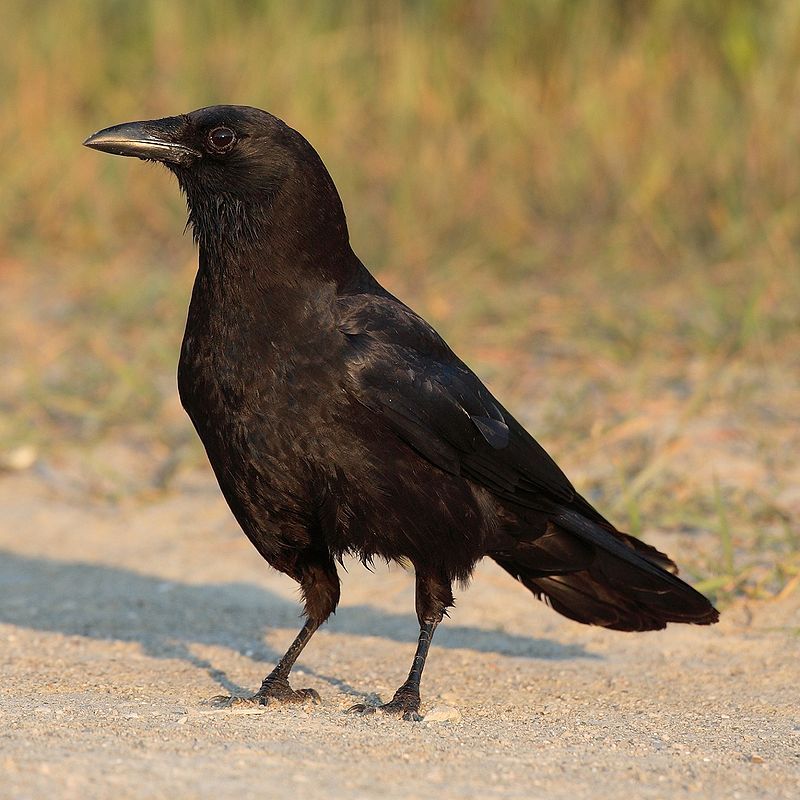
The American Crow is a large, all-black bird, measuring about 17-21 inches in length with a wingspan of 32-40 inches. They are highly adaptable and are commonly found in a wide range of habitats, including urban areas, farmlands, and woodlands.
American Crows are known for their distinctive “caw-caw” calls and vocal communication. They primarily feed on a varied diet, including insects, carrion, fruits, and even human food scraps.
They are often seen foraging in flocks. These crows are highly intelligent birds, known for their problem-solving abilities and complex social behaviors.
They build bulky stick nests in trees and are known for their communal roosts, which can number in the thousands during the winter months.
| Kingdom | Animalia |
| Phylum | Chordata |
| Clade | Dinosauria |
| Class | Aves |
| Order | Passeriformes |
| Family | Corvidae |
| Genus | Corvus |
| Species | C. brachyrhynchos |
20. Dark-Eyed Junco (Junco hyemalis)
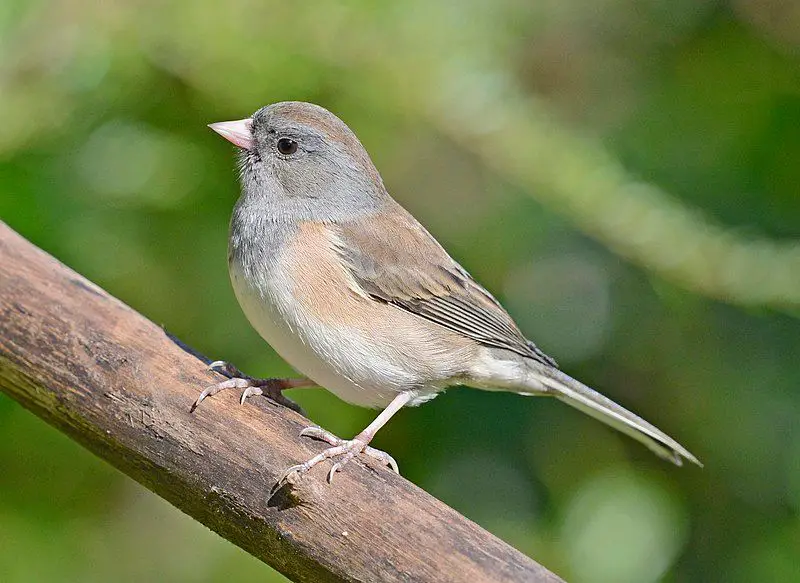
The Dark-Eyed Junco is a small, ground-dwelling sparrow, measuring about 5-6 inches in length. It has a grayish-black hood, white belly, and pinkish bill.
These sparrows are often seen foraging on the ground, where they primarily feed on seeds, including those from grasses and weeds.
Dark-eyed juncos are highly adaptable and are found in a variety of habitats, including forests, suburban areas, and alpine meadows.
They are known for their clear, musical trill and are often associated with the arrival of winter in many regions, as they migrate to lower elevations during colder months.
These juncos are social birds and are often seen in flocks, especially when foraging for food. They are known for their resilience in cold climates and are a common sight at bird feeders during the winter.
| Kingdom | Animalia |
| Phylum | Chordata |
| Clade | Dinosauria |
| Class | Aves |
| Order | Passeriformes |
| Family | Passerellidae |
| Genus | Junco |
| Species | J. hyemalis |
21. Red-Headed Woodpecker (Melanerpes erythrocephalus)
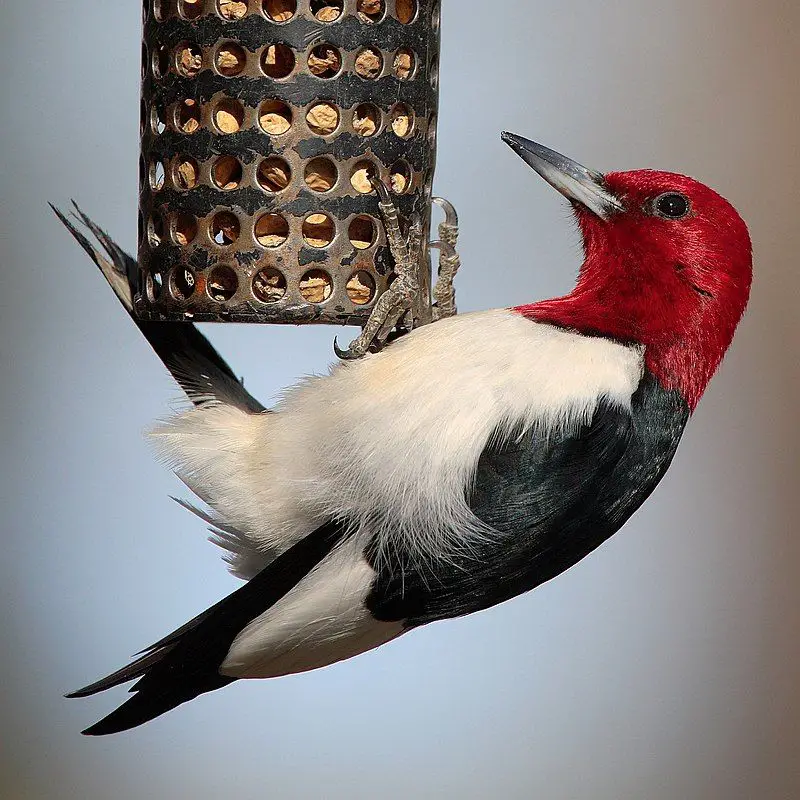
The Red-Headed Woodpecker is striking and colorful, measuring about 7-9 inches in length. As the name suggests, it features a bold red head, white body, and black wings with large white patches.
These woodpeckers are often found in open woodlands, forests, and wetlands across North America. They are known for their acrobatic flight, catching insects in mid-air and storing food in tree crevices.
Red-headed woodpeckers are omnivorous, feeding on insects, fruits, nuts, and occasionally small vertebrates. They are also known for their drumming on tree trunks and utility poles. These birds are highly territorial and defend their nesting and foraging areas vigorously.
| Kingdom | Animalia |
| Phylum | Chordata |
| Clade | Dinosauria |
| Class | Aves |
| Order | Piciformes |
| Family | Picidae |
| Genus | Melanerpes |
| Species | M. erythrocephalus |
22. Turkey Vulture (Cathartes aura)
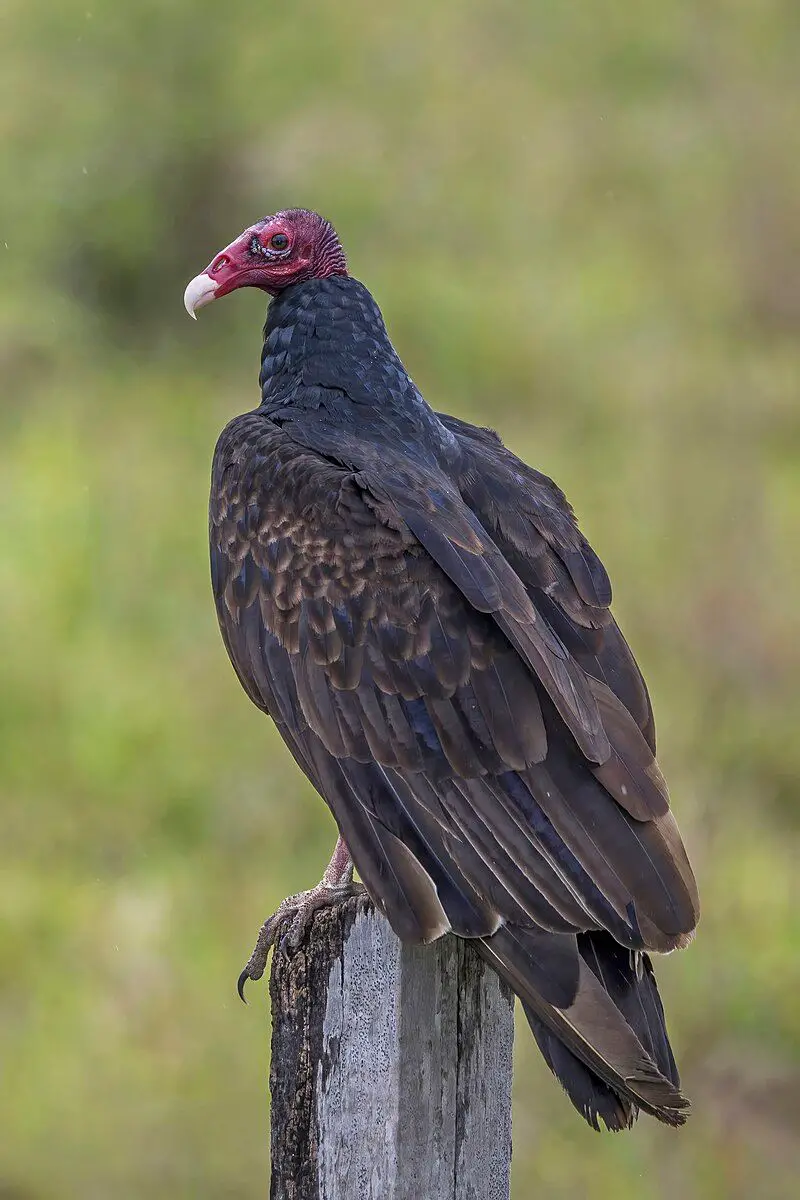
The Turkey Vulture is a large bird of prey, with a wingspan of 5.5-6.5 feet and a length of 25-32 inches. It has distinctive, dark plumage, a featherless red head, and keen eyesight. These vultures are commonly found soaring in the skies throughout North America.
They are scavengers, primarily feeding on carrion and dead animals. Turkey Vultures are known for their excellent sense of smell, allowing them to detect the scent of decaying flesh from high in the air.
They play a vital role in cleaning up the environment by disposing of carcasses. Despite their somewhat gruesome diet, they are beneficial to ecosystems.
Turkey Vultures are often seen in groups while roosting or soaring together in thermals. They are graceful in flight, holding their wings in a distinctive V-shape.
| Kingdom | Animalia |
| Phylum | Chordata |
| Clade | Dinosauria |
| Class | Aves |
| Order | Accipitriformes |
| Family | Cathartidae |
| Genus | Cathartes |
| Species | C. aura |
23. Eastern Phoebe (Sayornis phoebe)
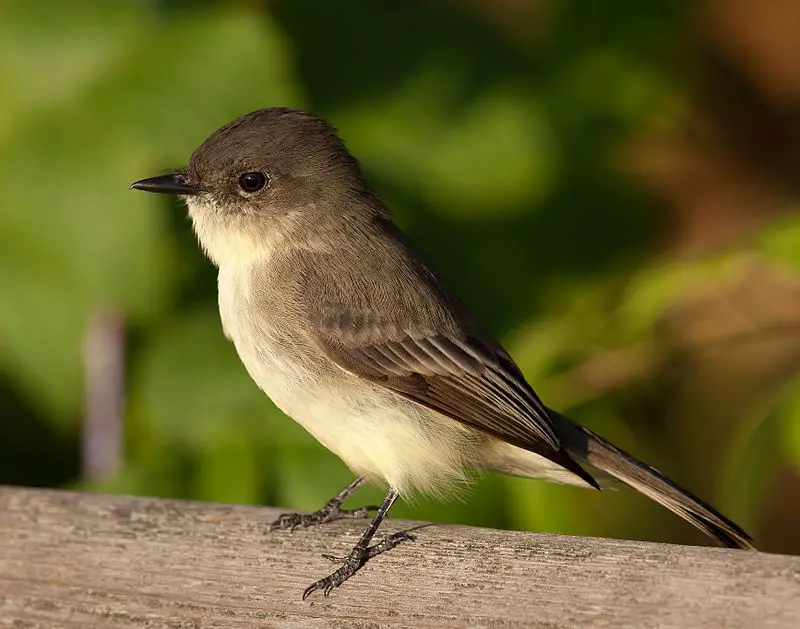
The Eastern Phoebe is a small, flycatching songbird, measuring about 5.5-7 inches in length. It has a plain grayish-brown plumage with a white belly.
These phoebes are commonly found in a variety of habitats, including woodlands, fields, and suburban areas across eastern North America.
They are known for their distinctive call, which sounds like their name, “fee-bee.” Eastern Phoebes primarily feed on flying insects, catching them on the wing. They are patient hunters, often perching on branches or fences before making short sallies to catch prey.
These birds are also known for their habit of nesting in human-made structures such as buildings and bridges, where they build cup-shaped nests of mud and moss. Eastern Phoebes are a welcome sight in many gardens, helping to control insect populations.
| Kingdom | Animalia |
| Phylum | Chordata |
| Clade | Dinosauria |
| Class | Aves |
| Order | Passeriformes |
| Family | Tyrannidae |
| Genus | Sayornis |
| Species | S. phoebe |
24. Red-winged Blackbird (Agelaius phoeniceus)
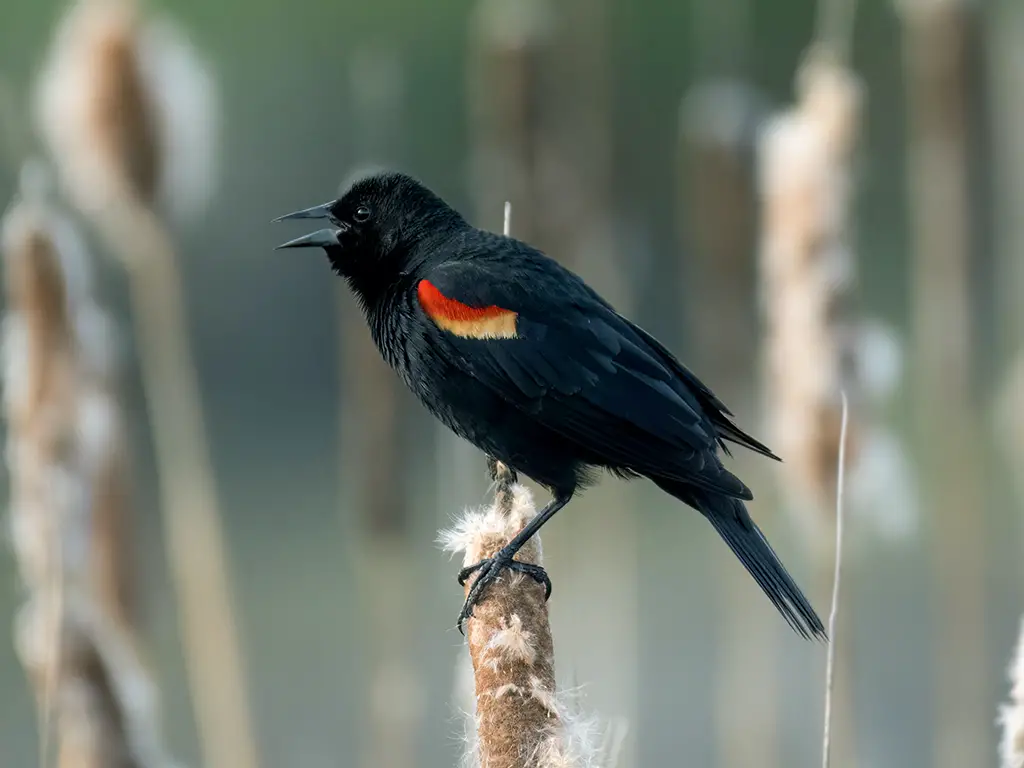
The Red-Winged Blackbird is a medium-sized songbird, measuring about 7-9 inches in length. Males are known for their striking black plumage with red shoulder patches, while females are brown with streaked markings.
These blackbirds are commonly found in wetlands, marshes, and grassy areas across North America. They are known for their distinctive “conk-la-ree” song, which they use to establish territories and attract mates.
Red-winged blackbirds are omnivorous, feeding on seeds, insects, and small invertebrates. They are also known for their aggressive behavior when defending their nesting territories.
These birds often perch prominently on cattails and reeds, singing and displaying their colorful shoulder patches. Red-winged blackbirds are a common and vibrant sight in wetland habitats.
| Kingdom | Animalia |
| Phylum | Chordata |
| Clade | Dinosauria |
| Class | Aves |
| Order | Passeriformes |
| Family | Icteridae |
| Genus | Agelaius |
| Species | A. phoeniceus |
25. White-Breasted Nuthatch (Sitta carolinensis)
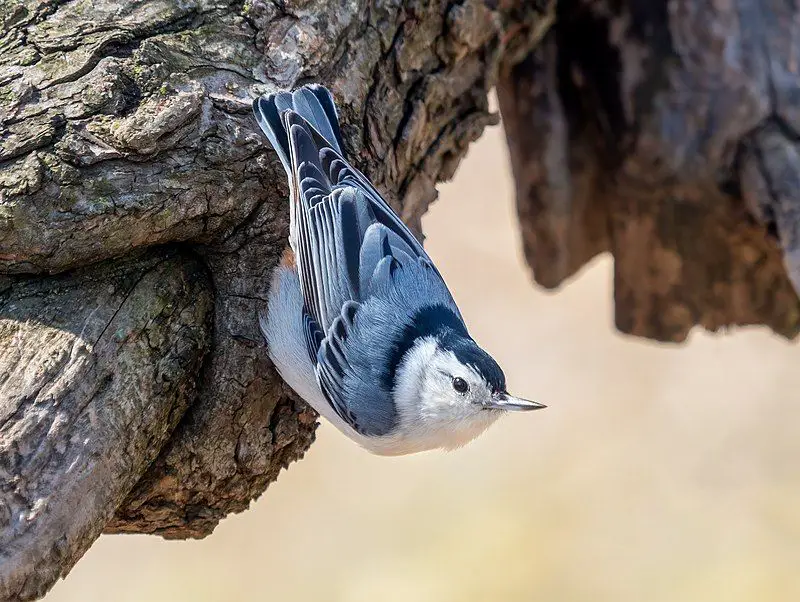
The White-Breasted Nuthatch is a small, compact songbird, measuring about 5.5-6 inches in length. It has a blue-gray upper body, a white face, and a distinctive black cap on its head.
These nuthatches are often found in deciduous and coniferous woodlands across North America. They are known for their nasal “yank-yank” calls and their unique habit of foraging headfirst down tree trunks.
White-Breasted Nuthatches primarily feed on insects, seeds, and nuts, often storing food in crevices in tree bark. They build their nests in tree cavities and are known for their diligence in lining the nest with sticky substances to deter predators.
These birds are agile climbers and are often seen in mixed-species foraging flocks during winter.
| Kingdom | Animalia |
| Phylum | Chordata |
| Clade | Dinosauria |
| Class | Aves |
| Order | Passeriformes |
| Family | Sittidae |
| Genus | Sitta |
| Species | S. carolinensis |
26. Eastern Towhee (Pipilo erythrophthalmus)
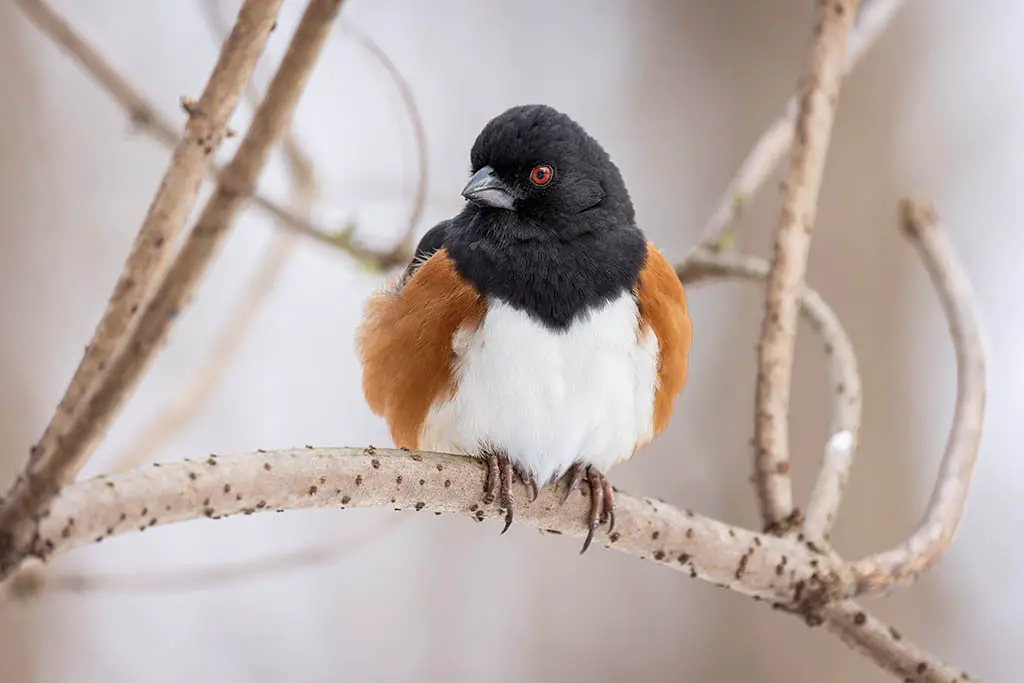
The Eastern Towhee is a medium-sized sparrow, measuring about 6.5-8 inches in length. Males have striking black plumage with white markings on the wings and red eyes, while females are brown with similar markings.
These towhees are often found in dense undergrowth, woodlands, and shrubby habitats across eastern North America.
They are known for their distinctive “drink-your-tea” song, with the males singing loudly from perches. Eastern Towhees primarily feed on seeds, insects, and leaf litter, using their strong bills to scratch through the forest floor in search of prey.
They are ground-dwelling birds and often hop and scratch in the leaf litter. These towhees are known for their bold and curious nature, making them a favorite among birdwatchers.
| Kingdom | Animalia |
| Phylum | Chordata |
| Clade | Dinosauria |
| Class | Aves |
| Order | Passeriformes |
| Family | Passerellidae |
| Genus | Pipilo |
| Species | P. erythrophthalmus |
27. Brown Thrasher (Toxostoma rufum)
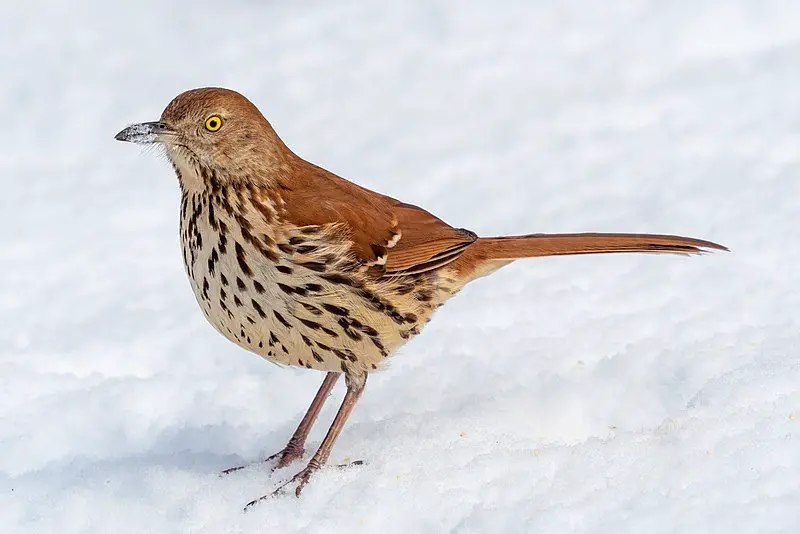
The Brown Thrasher is a medium-sized songbird, measuring about 9.5-11.5 inches in length. It has a distinctive reddish-brown plumage with streaked markings on its underparts and a long, slightly curved bill.
These thrashers are often found in dense shrubby areas, woodlands, and gardens across the southeastern United States. They are known for their rich and melodious song, which can include repeated phrases and mimicry of other birds.
Brown Thrashers primarily feed on insects, fruits, and berries, using their long bills to probe in leaf litter and soil.
They are ground foragers and are known for their habit of “thrashing” through the underbrush in search of prey. These birds are secretive and often stay hidden in dense vegetation.
| Kingdom | Animalia |
| Phylum | Chordata |
| Clade | Dinosauria |
| Class | Aves |
| Order | Passeriformes |
| Family | Mimidae |
| Genus | Toxostoma |
| Species | T. rufum |
28. Brown-Headed Nuthatch (Sitta pusilla)
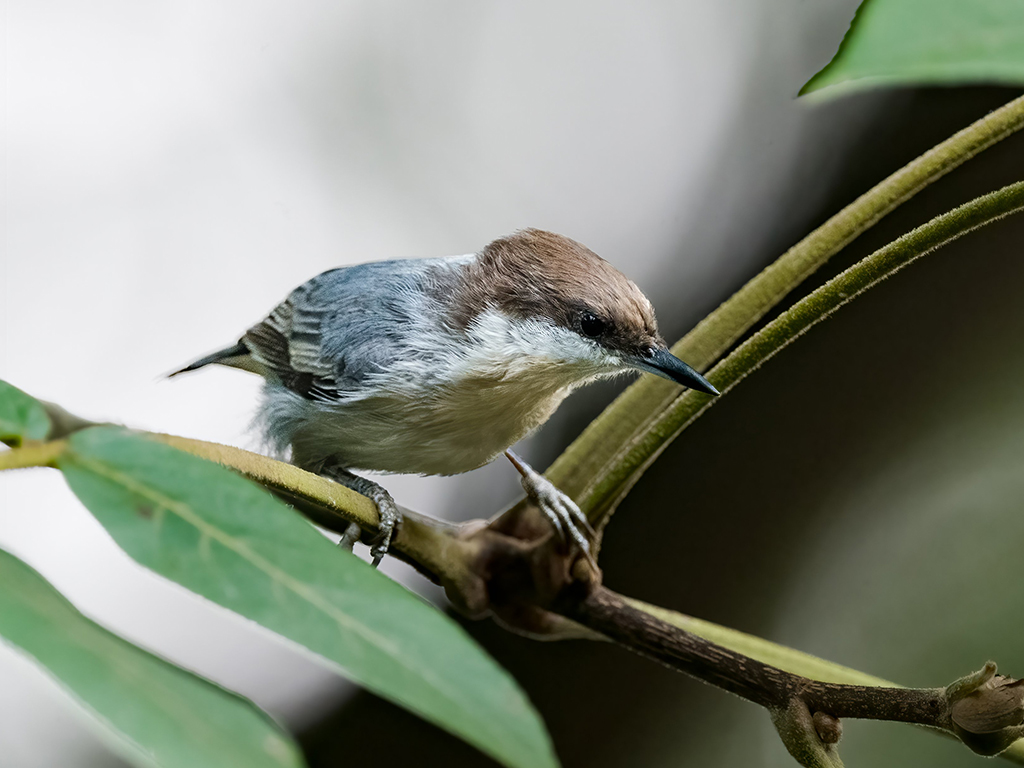
The Brown-Headed Nuthatch is a small, compact songbird, measuring about 3.9-4.7 inches in length. It has a blue-gray upper body, a white face, and a distinct brown cap on its head.
These nuthatches are primarily found in pine forests across the southeastern United States. They are known for their distinctive “ank-ank-ank” calls and their unique foraging behavior.
Brown-Headed Nuthatches primarily feed on insects and seeds, often using their bills to pry open pine cones and extract seeds.
They are agile climbers and are known for their ability to walk headfirst down tree trunks, much like their larger relatives.
These nuthatches are social birds and are often seen in small family groups or mixed-species foraging flocks. They are cavity nesters and often use old woodpecker holes for nesting.
| Kingdom | Animalia |
| Phylum | Chordata |
| Clade | Dinosauria |
| Class | Aves |
| Order | Passeriformes |
| Family | Sittidae |
| Genus | Sitta |
| Species | S. pusilla |
29. Northern Flicker (Colaptes auratus)
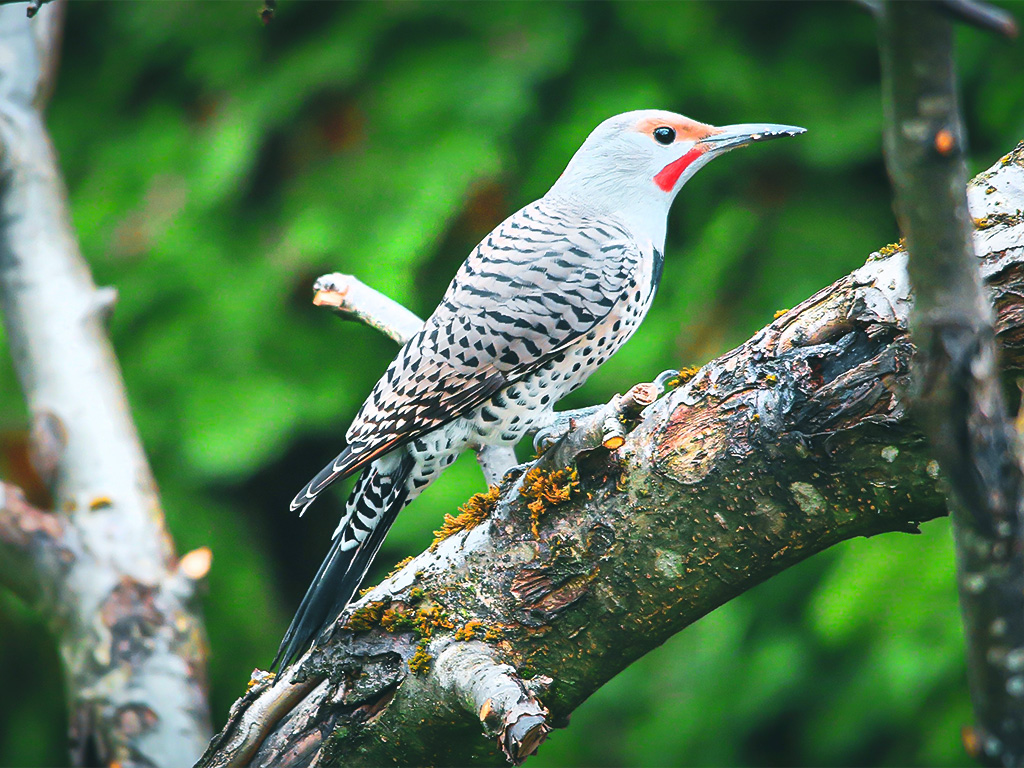
The Northern Flicker is a medium-sized woodpecker, measuring about 11-12 inches in length. It has a distinctive appearance with a beige or brown body, a black crescent on its chest, and prominent white rump patches.
Northern Flickers are often found in a variety of habitats, including woodlands, open fields, and urban areas across North America.
They are known for their unique feeding habits, often foraging on the ground for ants and beetles, using their long, pointed bills.
They also eat fruits and berries. These woodpeckers are recognizable by their “wick-a-wick-a-wick” calls and their loud, repeated “flicker” calls. Northern Flickers are cavity nesters and readily use nest boxes.
| Kingdom | Animalia |
| Phylum | Chordata |
| Clade | Dinosauria |
| Class | Aves |
| Order | Piciformes |
| Family | Picidae |
| Genus | Colaptes |
| Species | C. auratus |
30. Brown Creeper (Certhia americana)
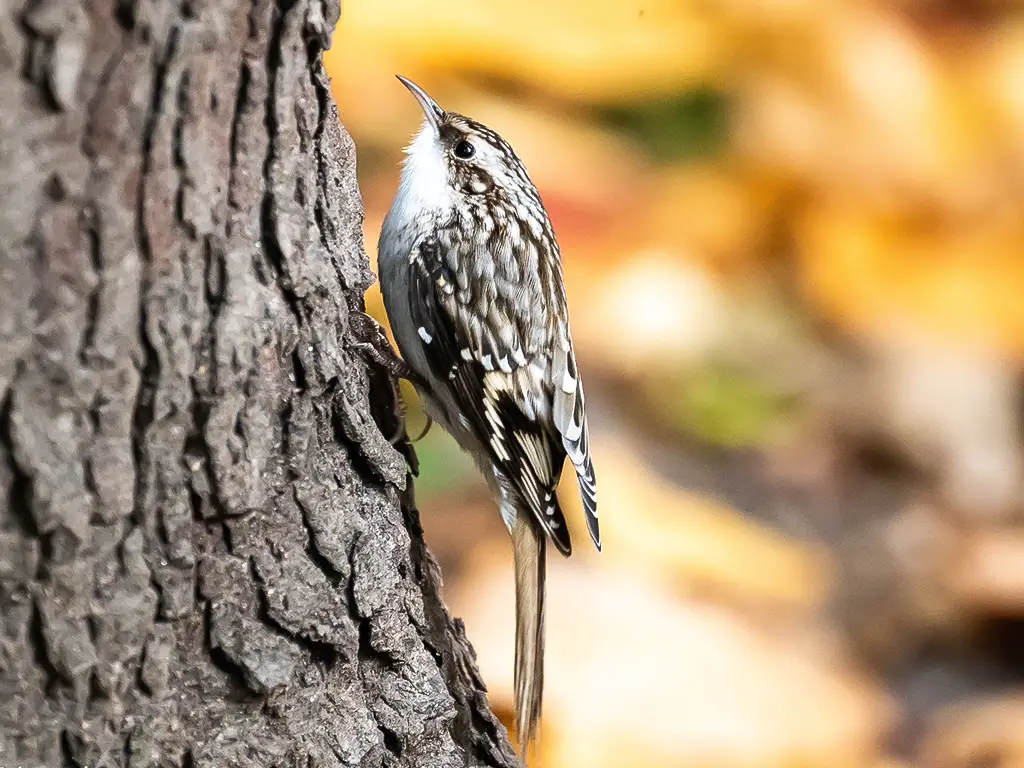
The Brown Creeper is a small, inconspicuous songbird, measuring about 4.7-5.1 inches in length. It has a streaked brown plumage with a long, downward-curving bill.
Brown Creepers are often found in mature forests and woodlands across North America. They are known for their distinctive habit of creeping up tree trunks and branches in search of insects and spiders.
Their cryptic plumage provides excellent camouflage against tree bark. These songbirds have soft, high-pitched calls and are often heard before they are seen.
Brown Creepers build cup-shaped nests behind loose bark on trees and are known for their secretive nesting behavior.
| Kingdom | Animalia |
| Phylum | Chordata |
| Clade | Dinosauria |
| Class | Aves |
| Order | Passeriformes |
| Family | Certhiidae |
| Genus | Certhia |
| Species | C. americana |
31. Yellow-Bellied Sapsucker (Sphyrapicus varius)
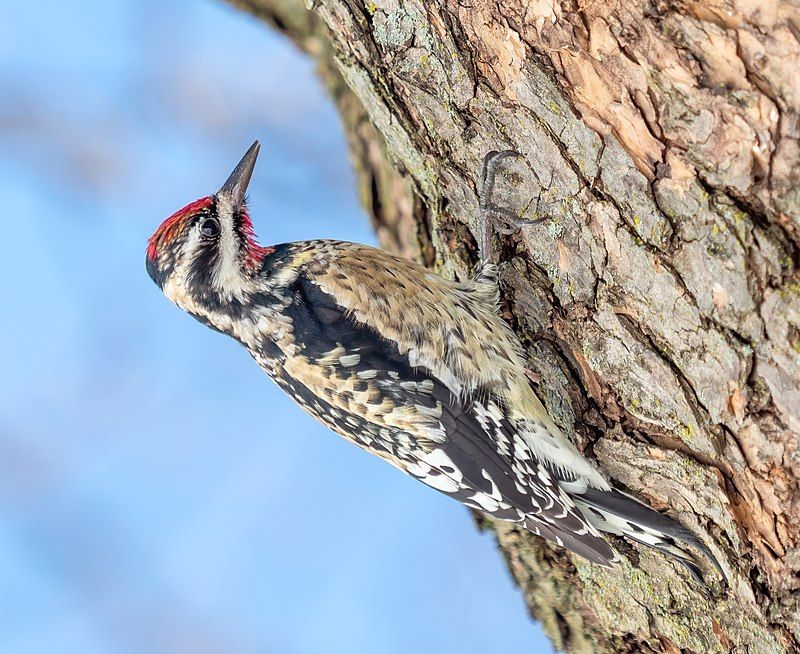
The Yellow-Bellied Sapsucker is a medium-sized woodpecker, measuring about 7-8 inches in length. It has a striking plumage with a black and white pattern, a red forehead, and a distinctive yellow belly.
These sapsuckers are primarily found in deciduous and mixed woodlands across eastern North America. They are known for their unique feeding behavior, drilling small holes in tree bark to access sap and insects.
These holes also attract hummingbirds and other birds. Yellow-bellied Sapsuckers have mewing calls and drumming sounds used for communication and territorial displays.
They are migratory birds, breeding in northern regions and wintering in the southern United States and Central America.
| Kingdom | Animalia |
| Phylum | Chordata |
| Clade | Dinosauria |
| Class | Aves |
| Order | Piciformes |
| Family | Picidae |
| Genus | Sphyrapicus |
| Species | S. varius |
32. Cedar Waxwing (Bombycilla cedrorum)
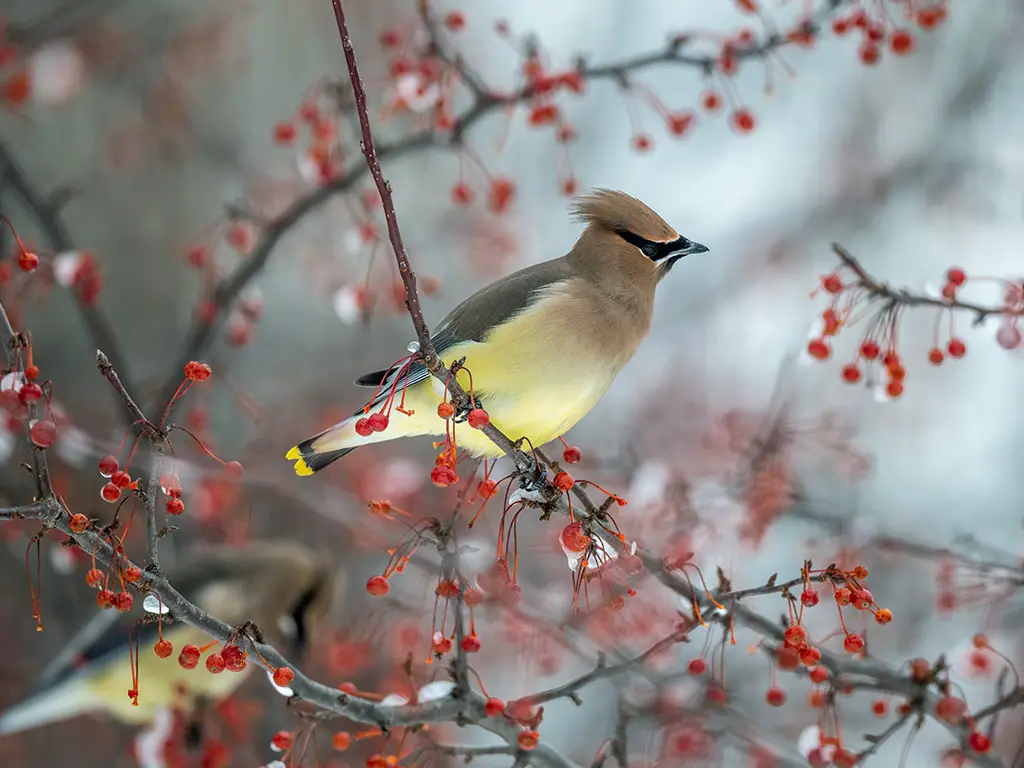
The Cedar Waxwing is a sleek, medium-sized songbird, measuring about 6.3-7.9 inches in length. It has a soft, brownish-gray plumage with a distinctive black mask, silky texture, and bright red wax-like tips on its secondary wing feathers.
Cedar Waxwings are often found in a variety of habitats, including woodlands, orchards, and suburban areas across North America. They are known for their high-pitched, whistled calls and their tendency to move in flocks.
These waxwings primarily feed on fruits, especially berries, which make up a significant portion of their diet. They are agile in flight, catching insects in mid-air as well.
Cedar Waxwings are known for their courtship rituals involving the passing of berries from one bird to another. These birds are social and often seen in groups.
| Kingdom | Animalia |
| Phylum | Chordata |
| Clade | Dinosauria |
| Class | Aves |
| Order | Passeriformes |
| Family | Bombycillidae |
| Genus | Bombycilla |
| Species | B. cedrorum |
33. Pine Siskin (Spinus pinus)
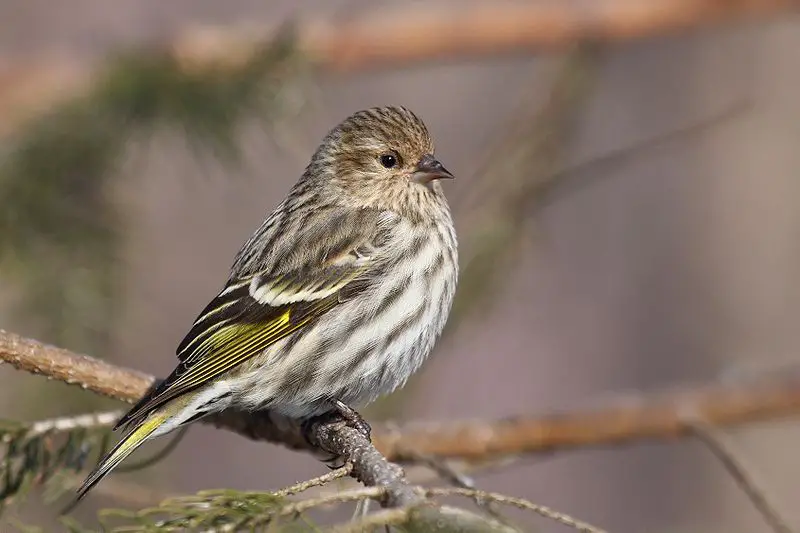
The Pine Siskin is a small finch, measuring about 4.3-5.5 inches in length. It has a streaked brown plumage with a pointed bill. Pine Siskins are often found in coniferous and mixed forests across North America.
They are known for their twittering and chattering calls. These finches primarily feed on seeds, especially those from conifer cones. Pine Siskins are highly nomadic, and their movements are often influenced by food availability.
During irruption years, they may appear in areas where they are not typically seen. They are also known for their social behavior and often forage in flocks. Pine Siskins are frequent visitors to bird feeders, where they can be observed feeding on sunflower seeds and thistles.
| Kingdom | Animalia |
| Phylum | Chordata |
| Clade | Dinosauria |
| Class | Aves |
| Order | Passeriformes |
| Family | Fringillidae |
| Genus | Spinus |
| Species | S. pinus |
34. Red-Breasted Nuthatch (Sitta canadensis)
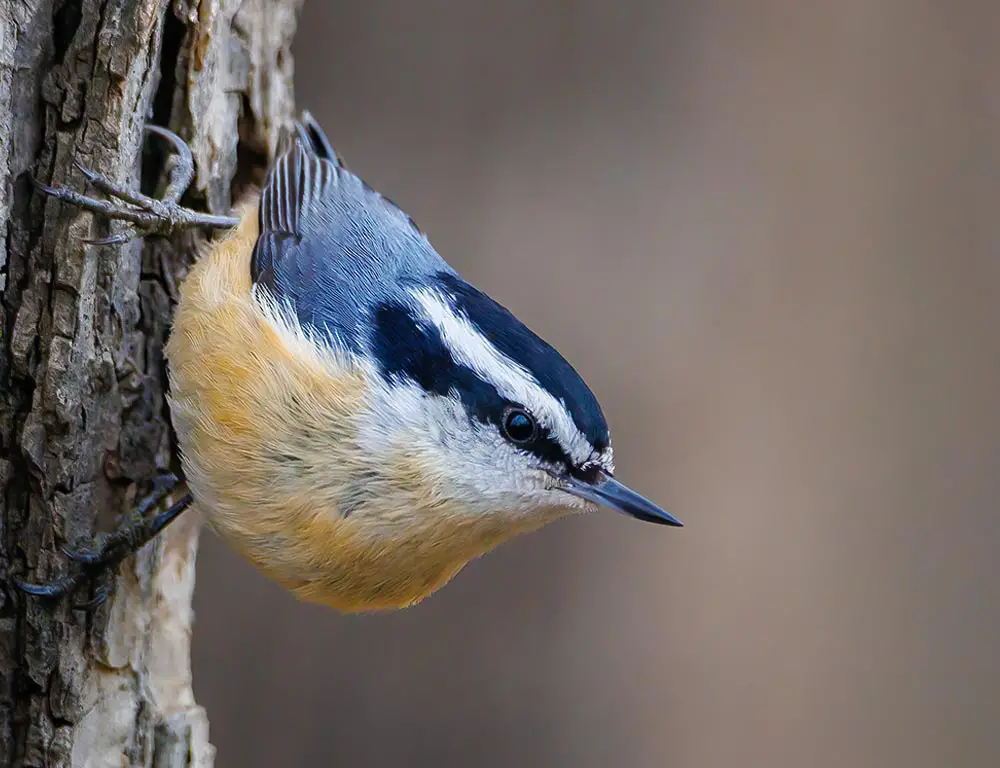
The Red-Breasted Nuthatch is a small songbird, measuring about 4.5-5 inches in length. It has a striking appearance with a blue-gray upper body, a white face, and a reddish-orange breast. These nuthatches are commonly found in coniferous forests across North America.
They are known for their nasal “yank-yank” calls and their distinctive habit of foraging headfirst down tree trunks. Red-breasted nuthatches primarily feed on insects and seeds, using their strong bills to extract prey from crevices in tree bark.
They are agile climbers and are often seen in mixed-species foraging flocks during winter. These nuthatches are known for their frequent visits to bird feeders, where they consume sunflower seeds and suet.
| Kingdom | Animalia |
| Phylum | Chordata |
| Clade | Dinosauria |
| Class | Aves |
| Order | Passeriformes |
| Family | Sittidae |
| Genus | Sitta |
| Species | S. canadensis |
35. Cyanocitta (Genus Cyanocitta)
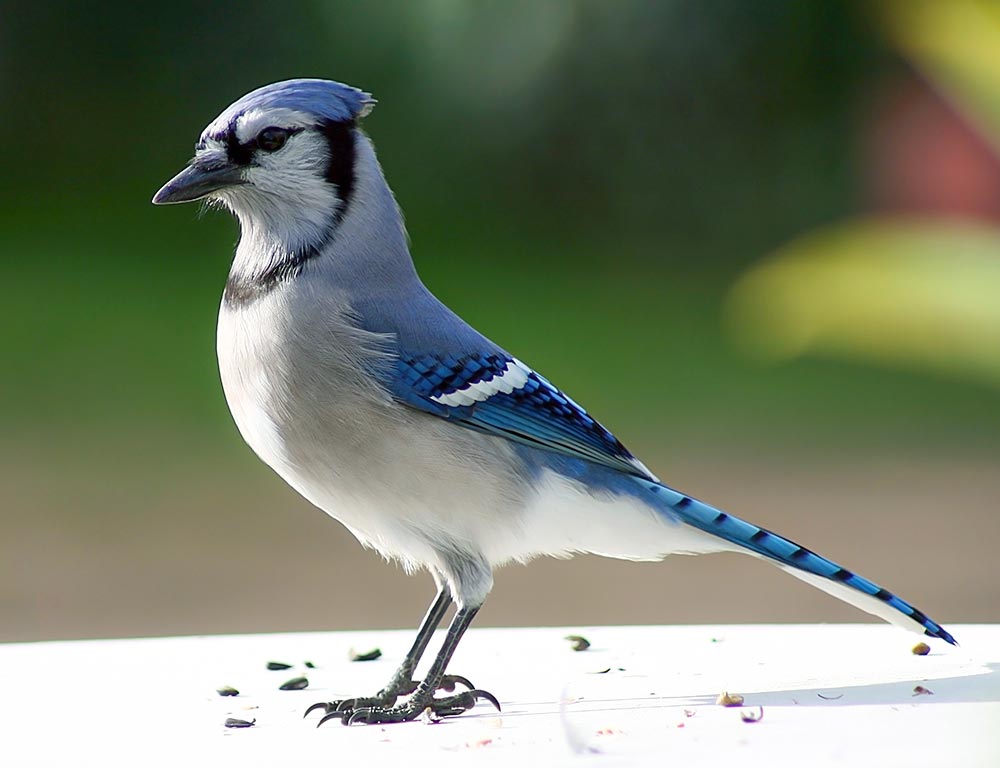
Cyanocitta is a genus of birds in the crow family, Corvidae, commonly known as jays. It includes several species found in North and Central America, such as the Blue Jay (Cyanocitta cristata) and the Steller’s Jay (Cyanocitta stelleri).
Jays in this genus are known for their vibrant plumage, including shades of blue and black. They are highly intelligent birds, often displaying complex social behaviors.
Jays are omnivorous, feeding on a varied diet that includes seeds, nuts, insects, and even small vertebrates. They are also known for their loud calls and vocalizations, which vary among species and are used for communication within their flocks.
| Kingdom | Animalia |
| Phylum | Chordata |
| Clade | Dinosauria |
| Class | Aves |
| Order | Passeriformes |
| Family | Corvidae |
| Genus | Cyanocitta |
36. Cardinalidae (Family Cardinalidae)
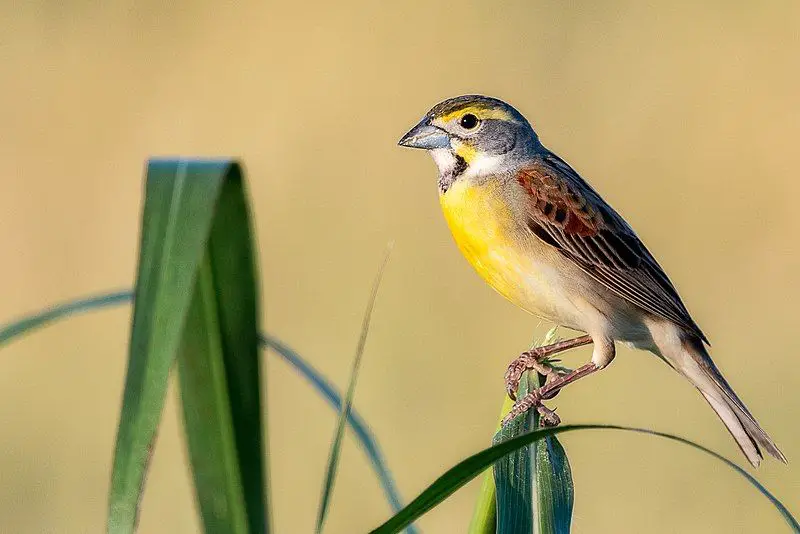
Cardinalidae is a diverse family of songbirds commonly known as cardinals and allies. This family includes well-known species like the Northern Cardinal (Cardinalis cardinalis), the Scarlet Tanager (Piranga olivacea), and the Rose-Breasted Grosbeak (Pheucticus ludovicianus).
Cardinals are often recognized for their bright and vibrant plumage, with males typically sporting striking reds and females displaying more subdued colors.
They are found across the Americas, with various species inhabiting different regions. Cardinalidae members primarily feed on seeds, fruits, insects, and nectar, depending on their specific dietary preferences.
These birds are known for their melodious songs and are often admired for their beauty and vocal talents.
| Kingdom | Animalia |
| Phylum | Chordata |
| Clade | Dinosauria |
| Class | Aves |
| Order | Passeriformes |
| Family | Cardinalidae |
37. Baltimore Oriole (Icterus galbula)
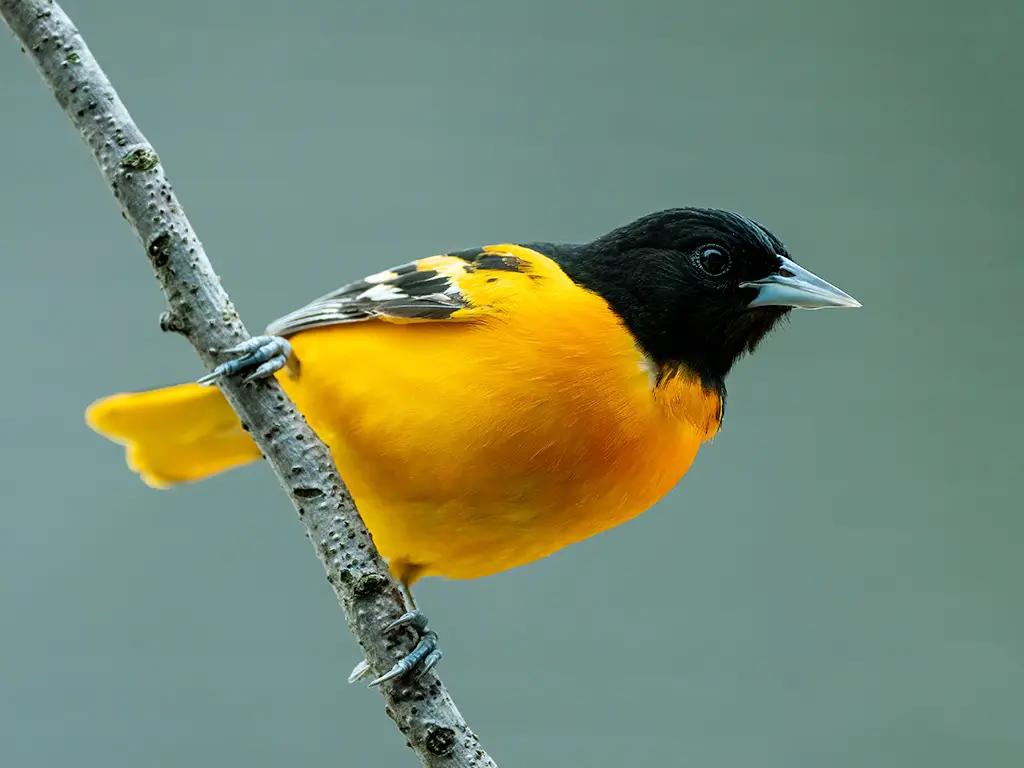
The Baltimore Oriole is a stunning songbird, measuring about 7-8 inches in length. Males are known for their vibrant orange plumage with black accents, while females have more subdued colors.
These orioles are commonly found in deciduous woodlands, gardens, and urban areas across eastern North America. They are known for their melodious, flute-like songs and their distinctive hanging nests woven from plant fibers.
Baltimore Orioles primarily feed on nectar, insects, and fruits, making them important pollinators. They are often attracted to feeders with offerings of orange halves and nectar.
These birds are a symbol of spring and are eagerly awaited by birdwatchers during their migration.
| Kingdom | Animalia |
| Phylum | Chordata |
| Clade | Dinosauria |
| Class | Aves |
| Order | Passeriformes |
| Family | Icteridae |
| Genus | Icterus |
| Species | I. galbula |
38. Great Blue Heron (Ardea herodias)

The Great Blue Heron is a majestic wading bird, measuring about 38-54 inches in height with a wingspan of 66-79 inches. It is the largest heron species in North America.
These herons are commonly found in wetlands, marshes, and along shorelines throughout North America. They are known for their tall stature, long necks, and gray-blue plumage.
Great Blue Herons are skilled hunters, primarily feeding on fish, amphibians, and small mammals. They use their sharp bills to strike at prey with precision.
These herons are often seen wading slowly through shallow waters, patiently waiting for an opportunity to catch their next meal. They are iconic and elegant birds, representing the beauty of wetland ecosystems.
| Kingdom | Animalia |
| Phylum | Chordata |
| Clade | Dinosauria |
| Class | Aves |
| Order | Pelecaniformes |
| Family | Ardeidae |
| Genus | Ardea |
| Species | A. herodias |
39. Great Egret (Ardea alba)
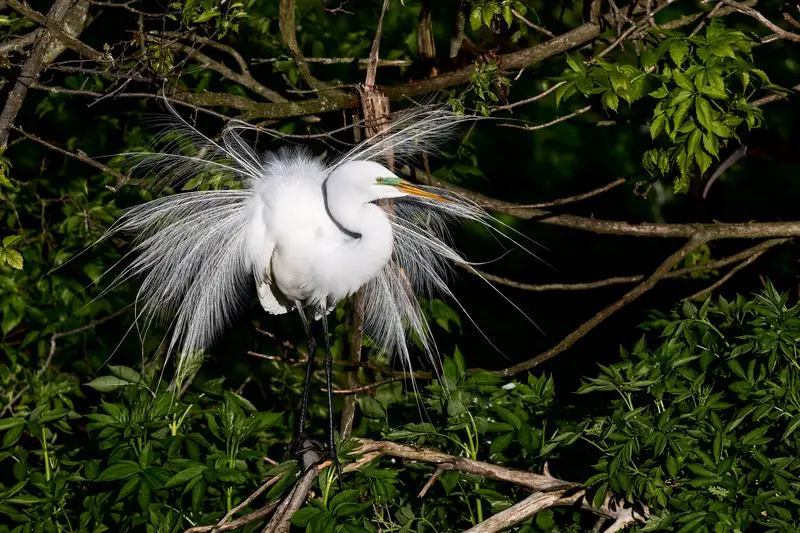
The Great Egret is a graceful wading bird known for its pristine white plumage, standing at an impressive height of 37-41 inches with a wingspan of 51-57 inches.
These elegant birds are often found in wetlands, marshes, and shallow waters throughout North America. They are known for their slow, deliberate hunting style, patiently stalking fish, frogs, and aquatic insects before striking with lightning speed.
Great Egrets are skilled hunters, using their long bills and sharp eyesight to locate prey. They are a symbol of wetland conservation and have made a remarkable recovery from near extinction due to plume hunting in the late 19th century. Their presence adds a touch of serenity to wetland habitats.
| Kingdom | Animalia |
| Phylum | Chordata |
| Clade | Dinosauria |
| Class | Aves |
| Order | Pelecaniformes |
| Family | Ardeidae |
| Genus | Ardea |
| Species | A. alba |
40. Canada Goose (Branta canadensis)
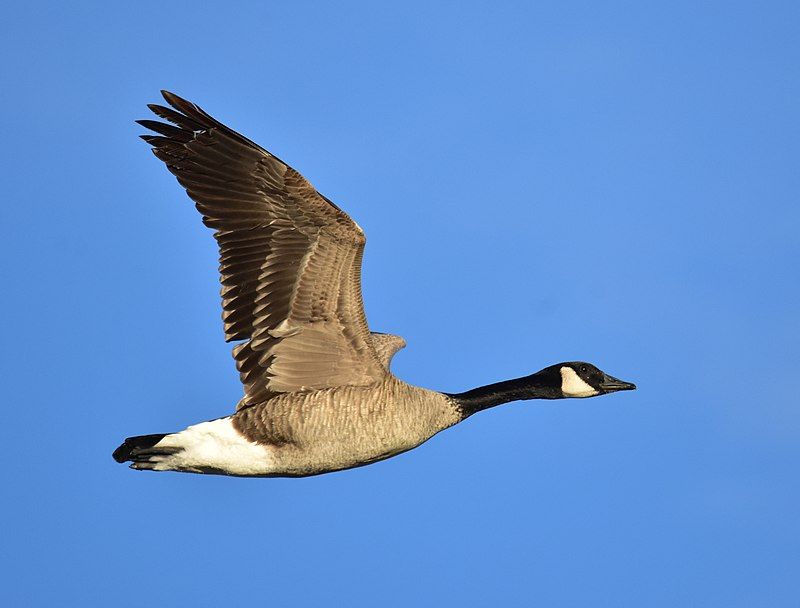
The Canada Goose is a familiar waterfowl species known for its distinctive black head, neck, and white chinstrap. These geese are large, with adults measuring 30-43 inches in length and having a wingspan of 50-71 inches. They are commonly found in a wide range of habitats, from urban parks and golf courses to lakes, rivers, and wetlands across North America. Canada Geese are known for their honking calls, which are a characteristic sound of migrating flocks. They are herbivorous grazers, feeding on a diet of grasses, aquatic plants, and grains. These geese are highly adaptable and have become a common sight in many urban and suburban areas.
| Kingdom | Animalia |
| Phylum | Chordata |
| Clade | Dinosauria |
| Class | Aves |
| Order | Anseriformes |
| Family | Anatidae |
| Genus | Branta |
| Species | B. canadensis |
41. Ruby-Throated Hummingbird (Archilochus colubris)
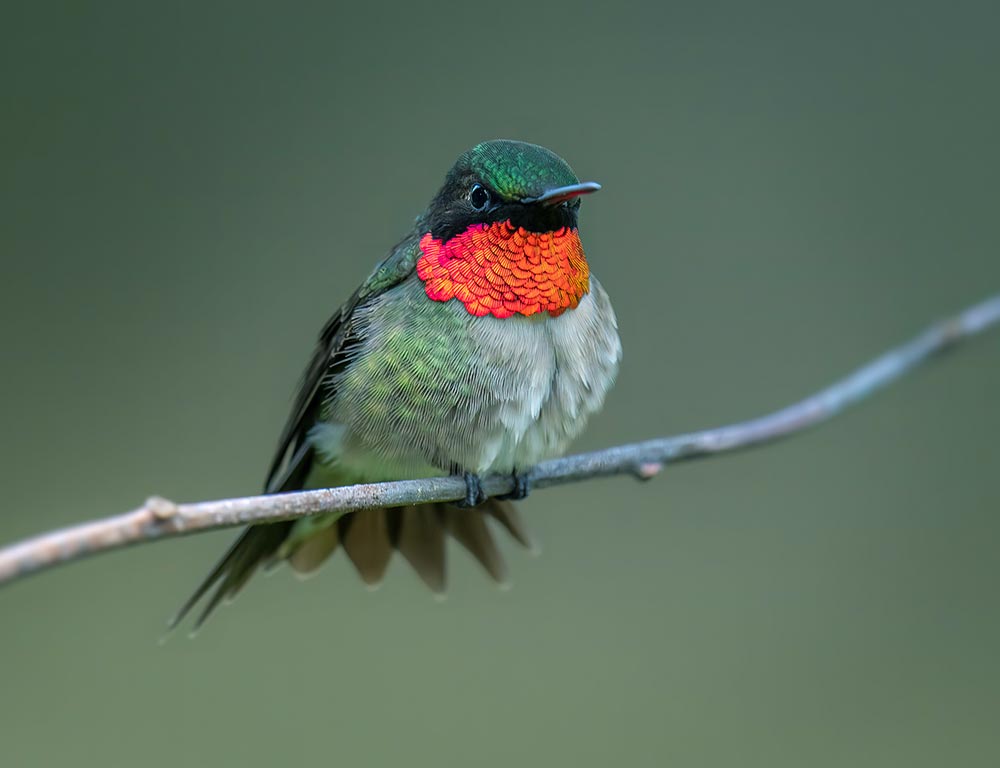
The Ruby-Throated Hummingbird is the only hummingbird species that breeds in eastern North America. It is tiny, measuring about 3-4 inches in length.
Males are known for their iridescent green plumage and vibrant ruby-red throats, while females have a more subdued appearance.
These hummingbirds are known for their incredible agility in flight, hovering in mid-air while feeding on nectar from flowers or sugar water from feeders.
They are also skilled at catching tiny insects in flight. Ruby-throated hummingbirds are migratory, traveling long distances between their breeding grounds in North America and their wintering grounds in Central America.
They are a beloved symbol of beauty and vitality in gardens and natural settings.
| Kingdom | Animalia |
| Phylum | Chordata |
| Clade | Strisores |
| Class | Aves |
| Order | Apodiformes |
| Family | Trochilidae |
| Genus | Archilochus |
| Species | A. colubris |
42. Common Grackle (Quiscalus quiscula)
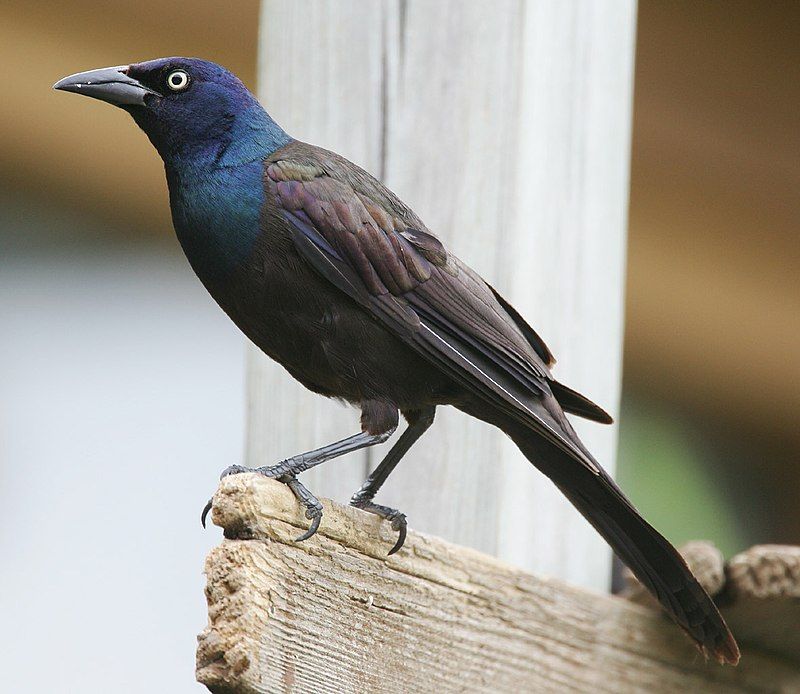
The Common Grackle is a blackbird species known for its iridescent plumage that shines with hues of blue, green, and purple. It measures about 11-13 inches in length.
These grackles are often found in a variety of habitats, including woodlands, marshes, and urban areas across North America. They are known for their loud and varied vocalizations, which include a distinctive “grackle” call.
Common Grackles are omnivorous, feeding on a diet of insects, fruits, seeds, and even small vertebrates. They are opportunistic foragers, often seen foraging on the ground or visiting bird feeders.
During the breeding season, males display their striking iridescent plumage and engage in elaborate courtship displays to attract females.
| Kingdom | Animalia |
| Phylum | Chordata |
| Clade | Dinosauria |
| Class | Aves |
| Order | Passeriformes |
| Family | Icteridae |
| Genus | Quiscalus |
| Species | Q. quiscula |
43. Indigo Bunting (Passerina cyanea)
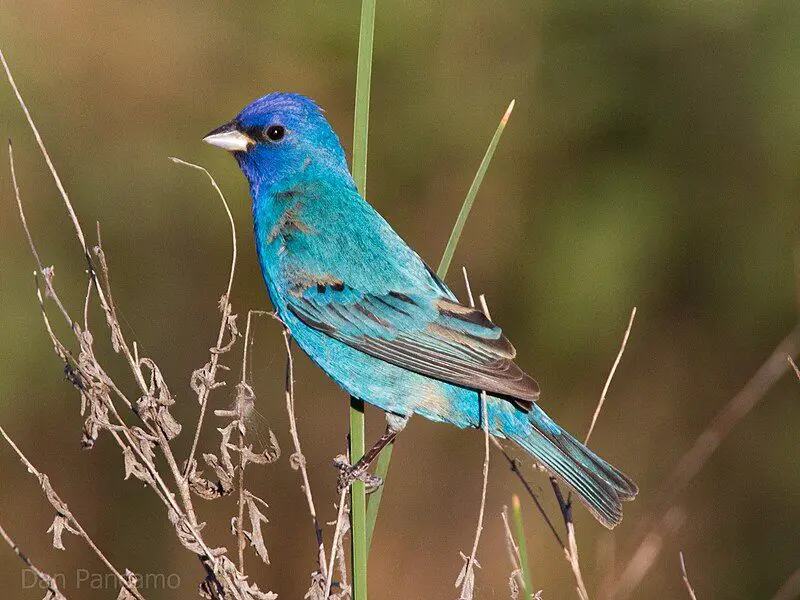
The Indigo Bunting is a small, vibrant songbird, measuring about 4.3-5.1 inches in length. Males are known for their stunning all-blue plumage, while females have more subdued brown plumage.
These buntings are often found in a variety of habitats, including woodlands, meadows, and gardens across eastern North America. They are known for their cheerful and melodious songs, which sound like a series of musical notes.
Indigo Buntings primarily feed on seeds, insects, and berries. They are often attracted to bird feeders with sunflower seeds. These beautiful birds are a delight for birdwatchers, and their striking blue colors make them a sought-after sight in gardens and natural areas.
| Kingdom | Animalia |
| Phylum | Chordata |
| Clade | Dinosauria |
| Class | Aves |
| Order | Passeriformes |
| Family | Cardinalidae |
| Genus | Passerina |
| Species | P. cyanea |
44. Common Starling (Sturnus vulgaris)
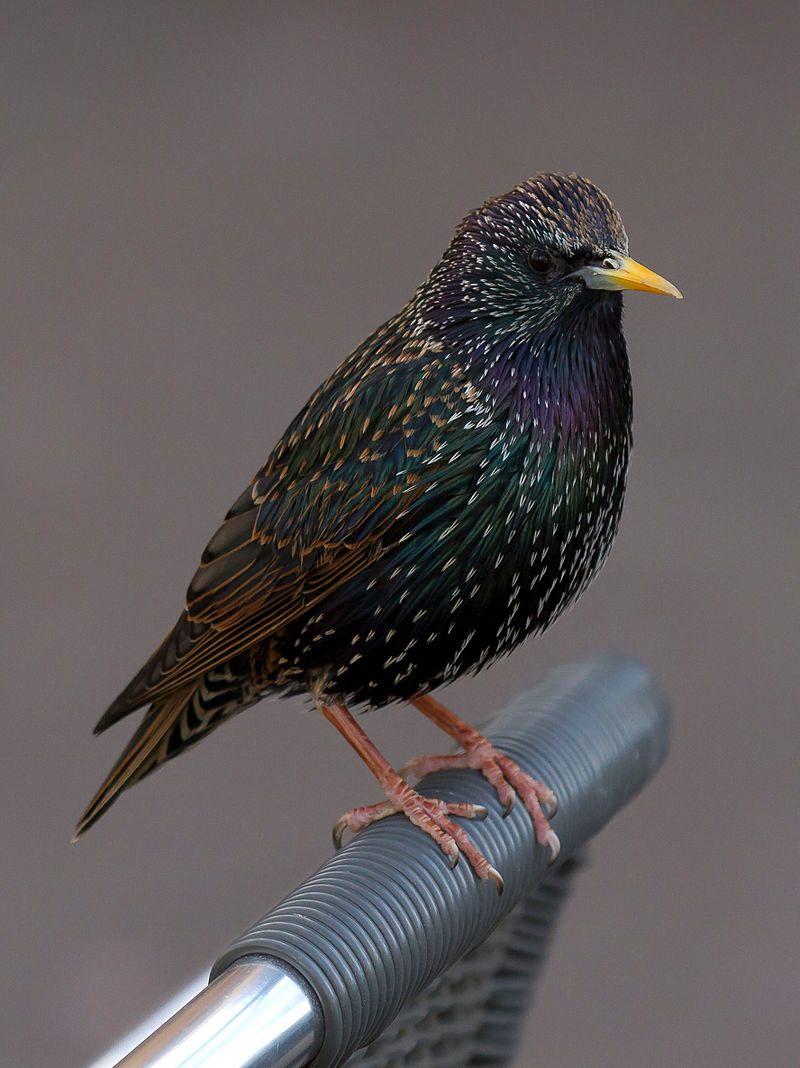
The Common Starling, a small to medium-sized passerine bird, is known for its iridescent black plumage which shows shades of green and purple in the light.
It has a short tail, pointed wings, and a relatively long, slender beak. Native to Europe, Asia, and North Africa, this bird has been introduced to Australia, New Zealand, and North America.
It’s a highly social species, often seen in large flocks. Starlings are omnivorous, feeding on insects, fruits, and seeds.
They are known for their vocal abilities, mimicking various sounds and even human speech. Starlings nest in cavities and can adapt to various habitats, including urban areas.
| Kingdom | Animalia |
| Phylum | Chordata |
| Clade | Dinosauria |
| Class | Aves |
| Order | Passeriformes |
| Family | Sturnidae |
| Genus | Sturnus |
| Species | S. vulgaris |
45. Swainson’s Thrush (Catharus ustulatus)
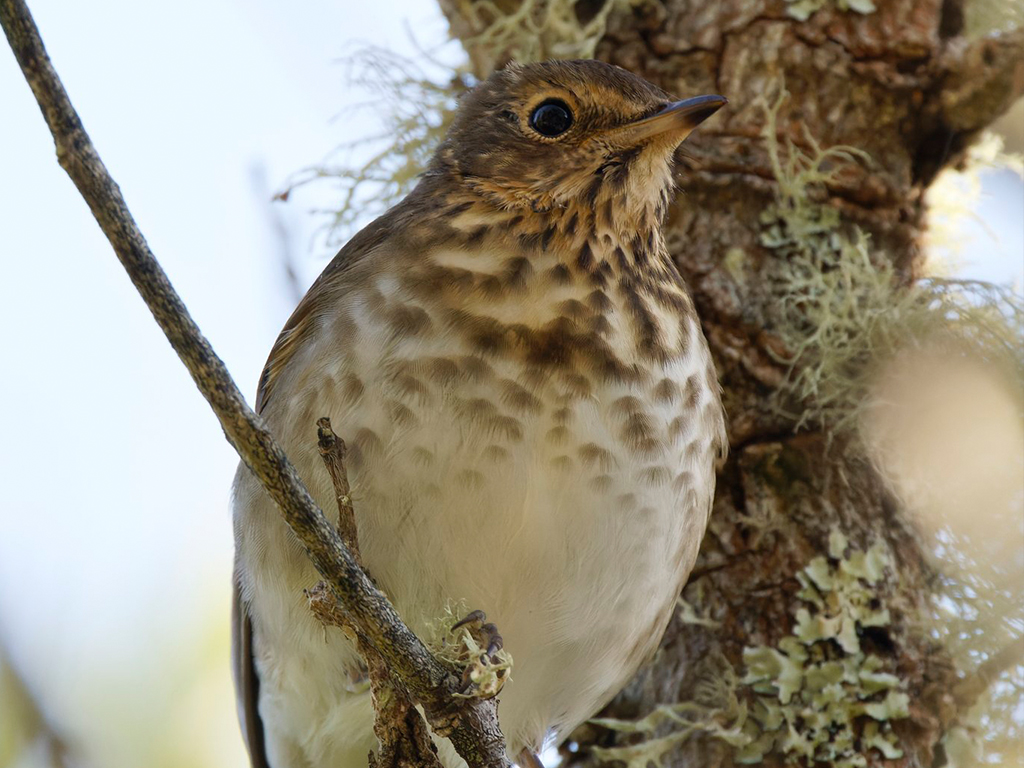
SSwainson’s Thrush is a small North American songbird, renowned for its melodious flute-like song. It has an olive-brown upper body and a white underpart with distinct buffy wash and dark spots on the throat.
The bird’s face features a pale eye-ring and a distinct buffy-colored line above the eye. Swainson’s Thrush primarily inhabits forested areas, particularly in regions with dense understory.
It feeds on insects and fruits, often foraging on the forest floor. During migration, it travels long distances between North America and South America. Swainson’s Thrush plays an important role in seed dispersal due to its fruit diet.
| Kingdom | Animalia |
| Phylum | Chordata |
| Clade | Dinosauria |
| Class | Aves |
| Order | Passeriformes |
| Family | Turdidae |
| Genus | Catharus |
| Species | C. ustulatus |
46. Barred Owl (Strix varia)
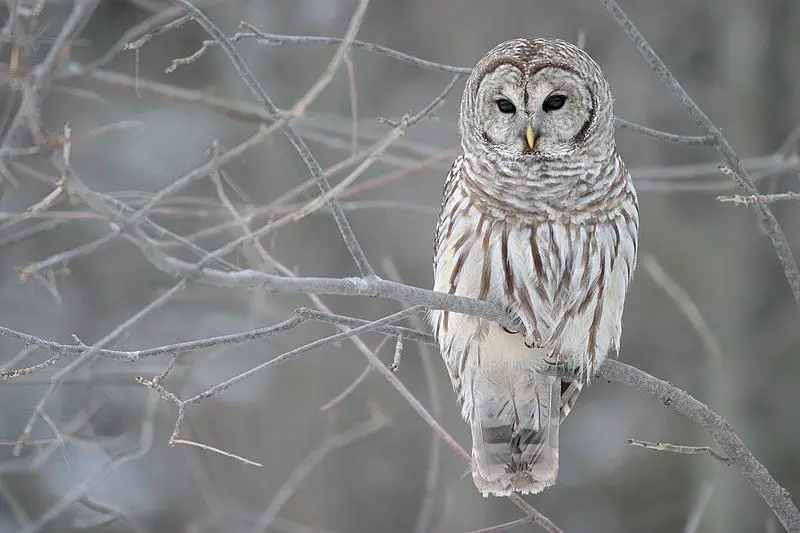
The Barred Owl is a large North American owl, notable for its distinctive “who cooks for you” call. It has a round head with no ear tufts, dark eyes, and a yellow beak.
The bird’s plumage is mottled brown and white, with horizontal bars on the chest and vertical streaks on the belly. Barred Owls prefer dense woods with large trees, often near water.
They are nocturnal predators, hunting small mammals, birds, and invertebrates. Unlike other owl species, Barred Owls are known to be quite vocal during the day.
They are territorial and monogamous, often using the same nesting site for many years.
| Kingdom | Animalia |
| Phylum | Chordata |
| Clade | Dinosauria |
| Class | Aves |
| Order | Strigiformes |
| Family | Strigidae |
| Genus | Strix |
| Species | S. varia |
47. Eastern Screech Owl (Megascops asio)
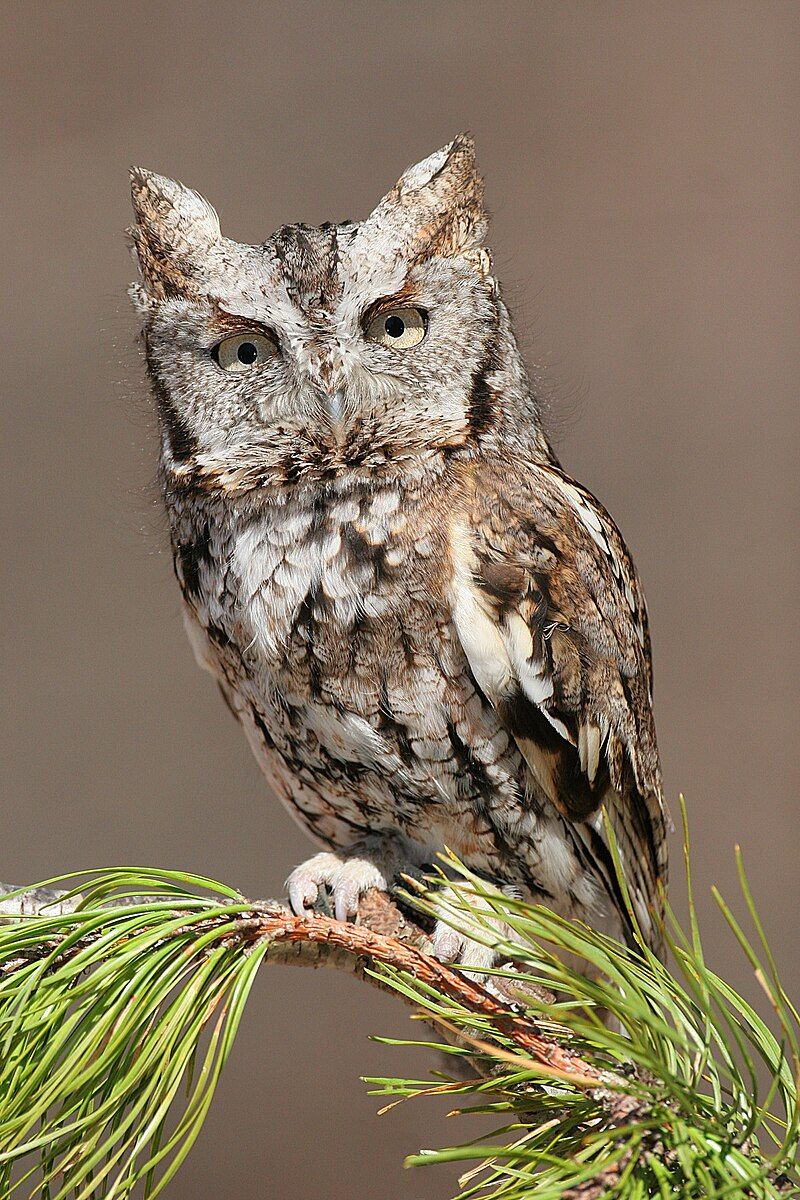
The Eastern Screech Owl, a small owl species found in North America, is known for its trilling and whinnying calls. It comes in two color morphs: a gray phase and a red (rufous) phase, providing excellent camouflage against tree bark.
This owl has prominent ear tufts, yellow eyes, and a stocky body. It inhabits a variety of woodland habitats, including suburban areas.
The Eastern Screech Owl preys on insects, small mammals, and birds. It nests in tree cavities and is known for its adaptability to human-altered environments. Despite its name, it doesn’t screech; its call is more of a soft trill.
| Kingdom | Animalia |
| Phylum | Chordata |
| Clade | Dinosauria |
| Class | Aves |
| Order | Strigiformes |
| Family | Strigidae |
| Genus | Megascops |
| Species | M. asio |
48. Purple Finch (Haemorhous purpureus)
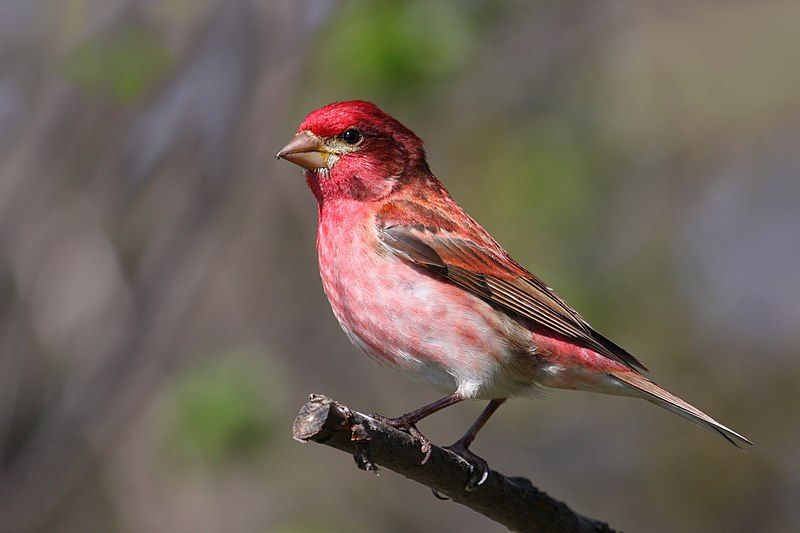
| Kingdom | Animalia |
| Phylum | Chordata |
| Clade | Dinosauria |
| Class | Aves |
| Order | Passeriformes |
| Family | Fringillidae |
| Genus | Haemorhous |
| Species | H. purpureus |
49. Rufous Hummingbird (Selasphorus rufus)
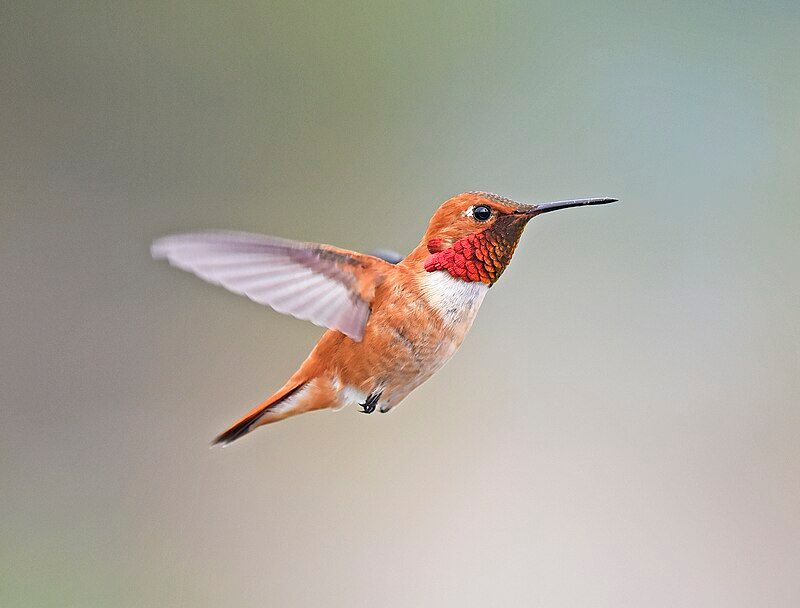
The Rufous Hummingbird, a small and vibrant bird, is known for its remarkable long-distance migration, traveling from breeding grounds in the Pacific Northwest and Alaska to wintering areas in Mexico.
The male Rufous Hummingbird is particularly striking with its bright orange-red throat and white breast. Its back and tail are also a rich rufous color, while the female and young birds are more muted with green and white plumage and some rufous markings.
This species is highly territorial and often aggressive at feeding sites. Rufous Hummingbirds feed primarily on nectar from flowers and feeders, supplementing their diet with insects and spiders.
They are known for their incredible agility and speed, often seen hovering or darting between flowers.
| Kingdom | Animalia |
| Phylum | Chordata |
| Clade | Strisores |
| Class | Aves |
| Order | Apodiformes |
| Family | Trochilidae |
| Genus | Selasphorus |
| Species | S. rufus |
Conclusion
Winter birds in South Carolina bring a sense of wonder and beauty to the natural habitats of the state. These migratory species, such as the painted bunting, cedar waxwing, and red-headed woodpecker, add vibrant colors and melodious songs to the winter landscape.
Their presence enhances the biodiversity of South Carolina’s ecosystems and provides a unique opportunity for bird enthusiasts to observe and appreciate these remarkable creatures.
While their stay may be temporary, the impact of winter birds on the local environment and communities is lasting and invaluable.
South Carolina’s winter birds serve as a reminder of the importance of preserving and protecting natural habitats for the benefit of both wildlife and humans.